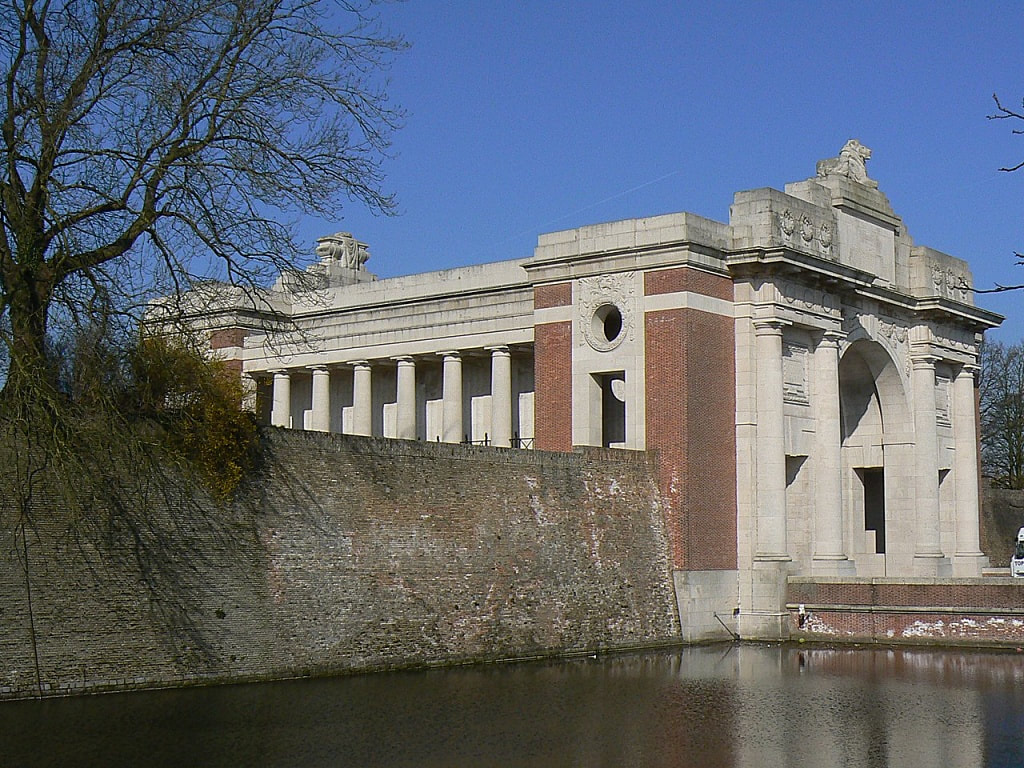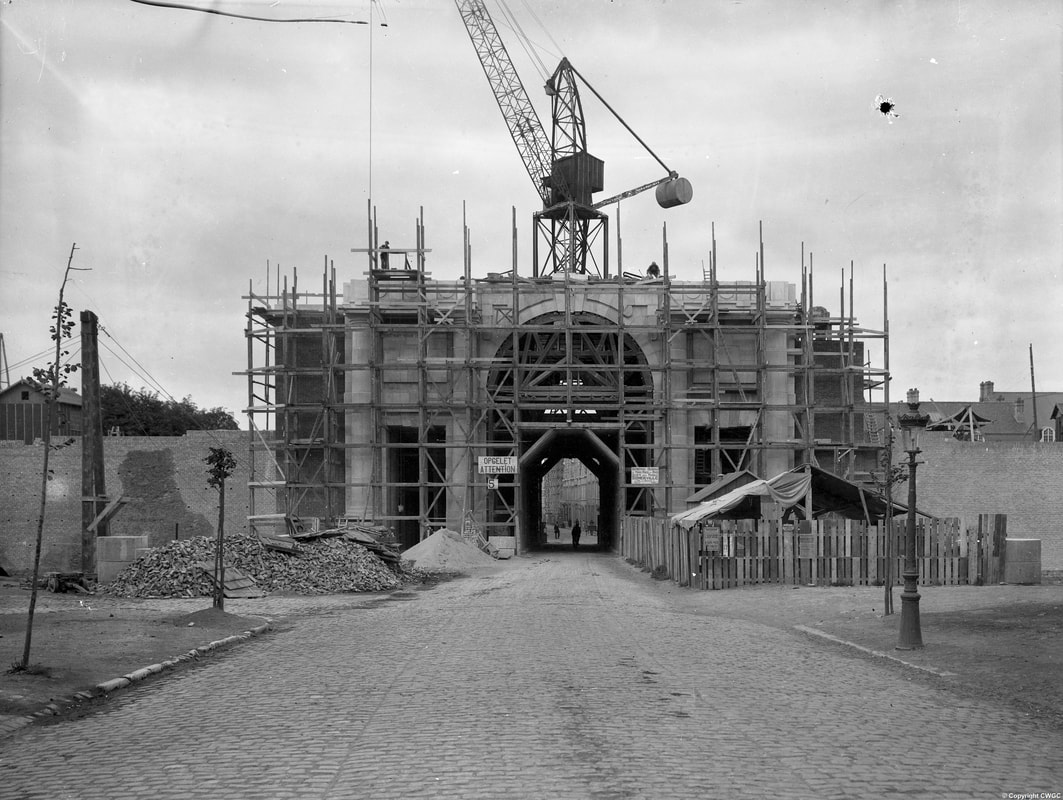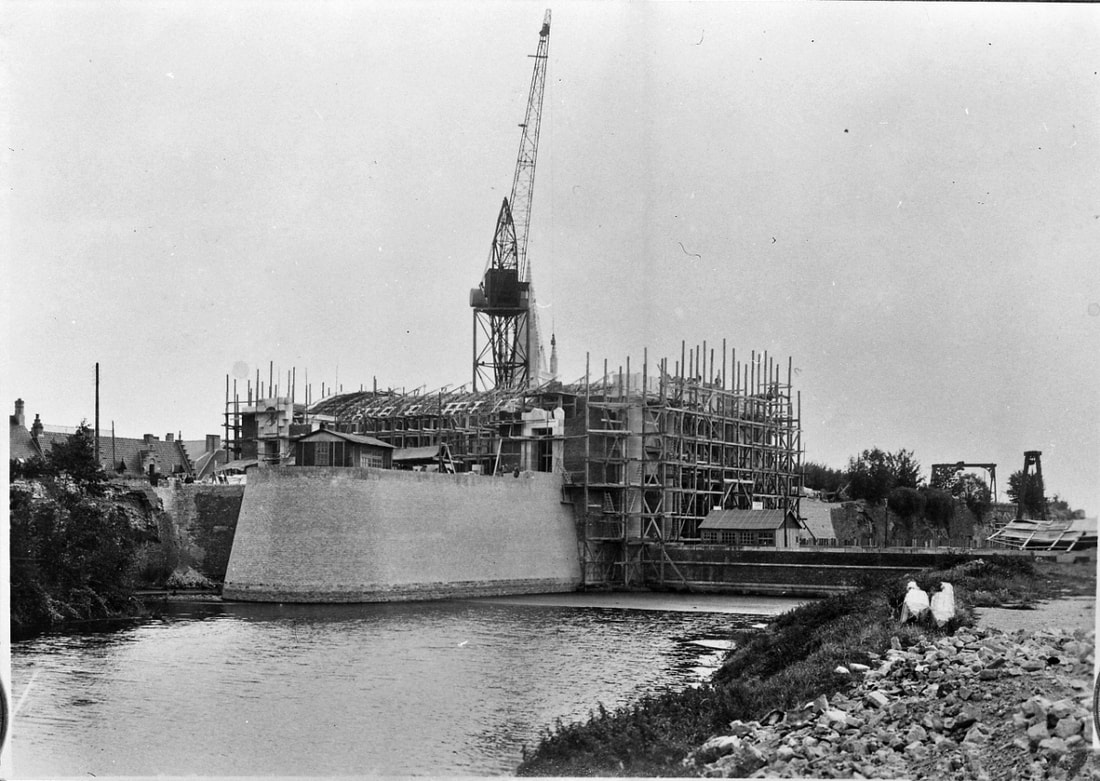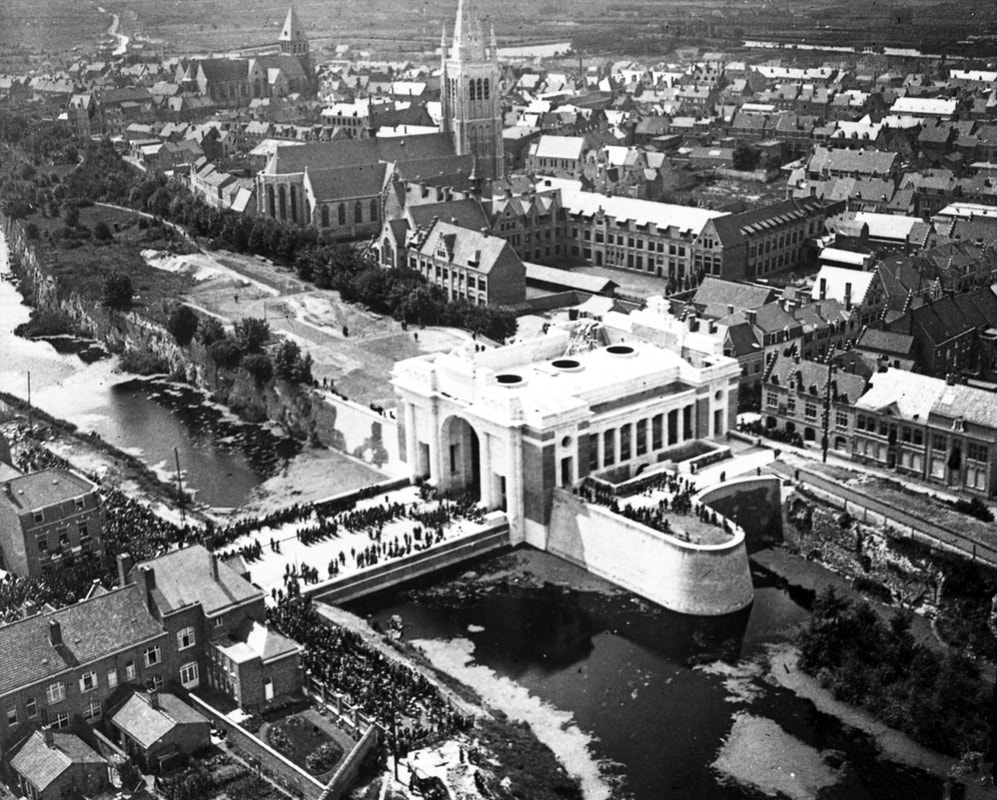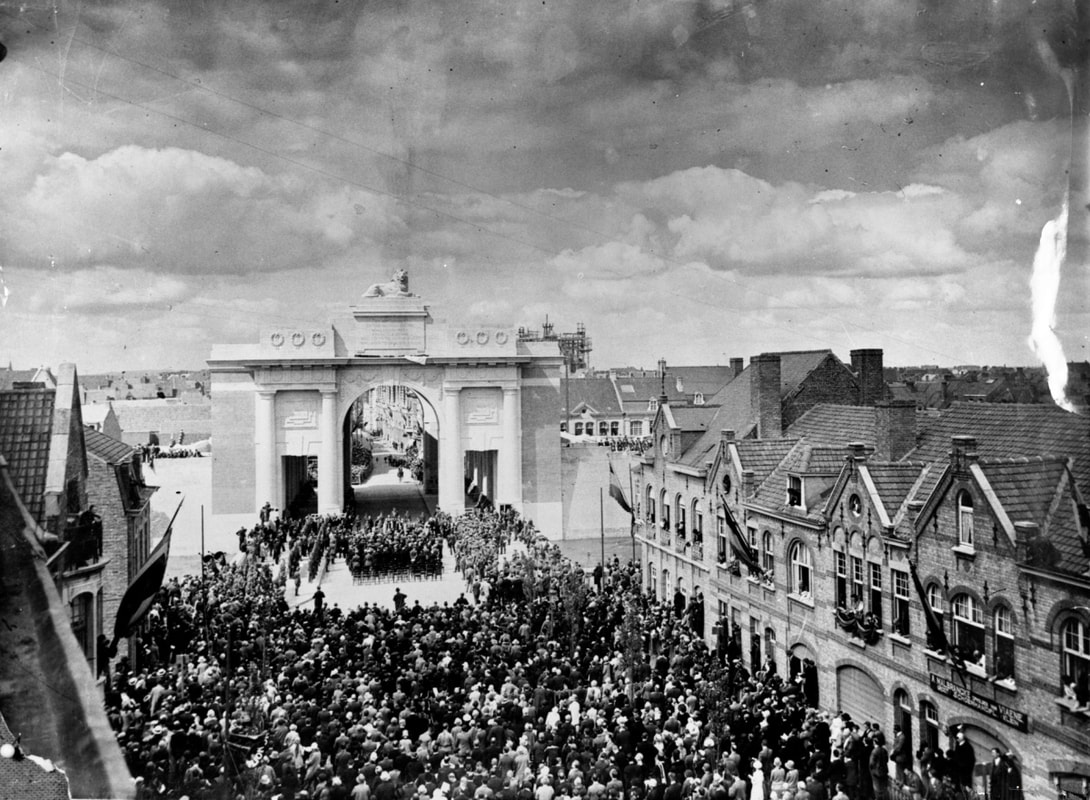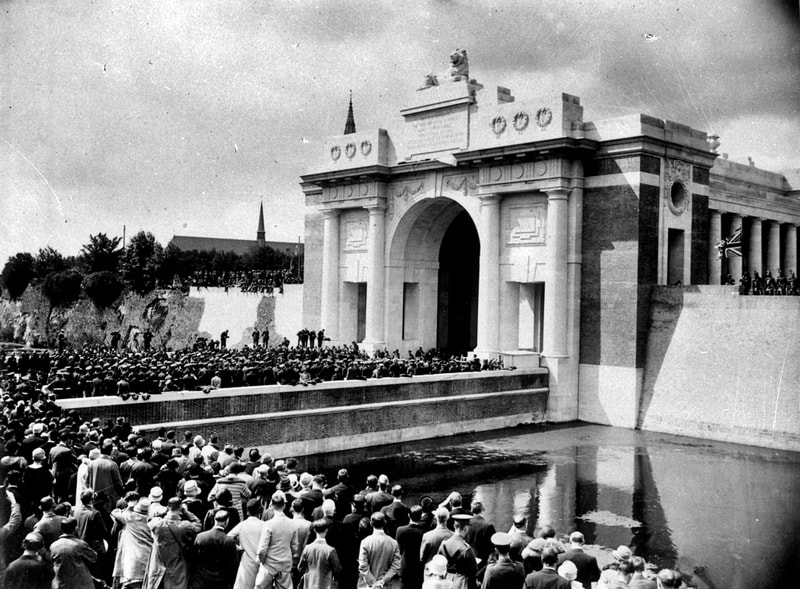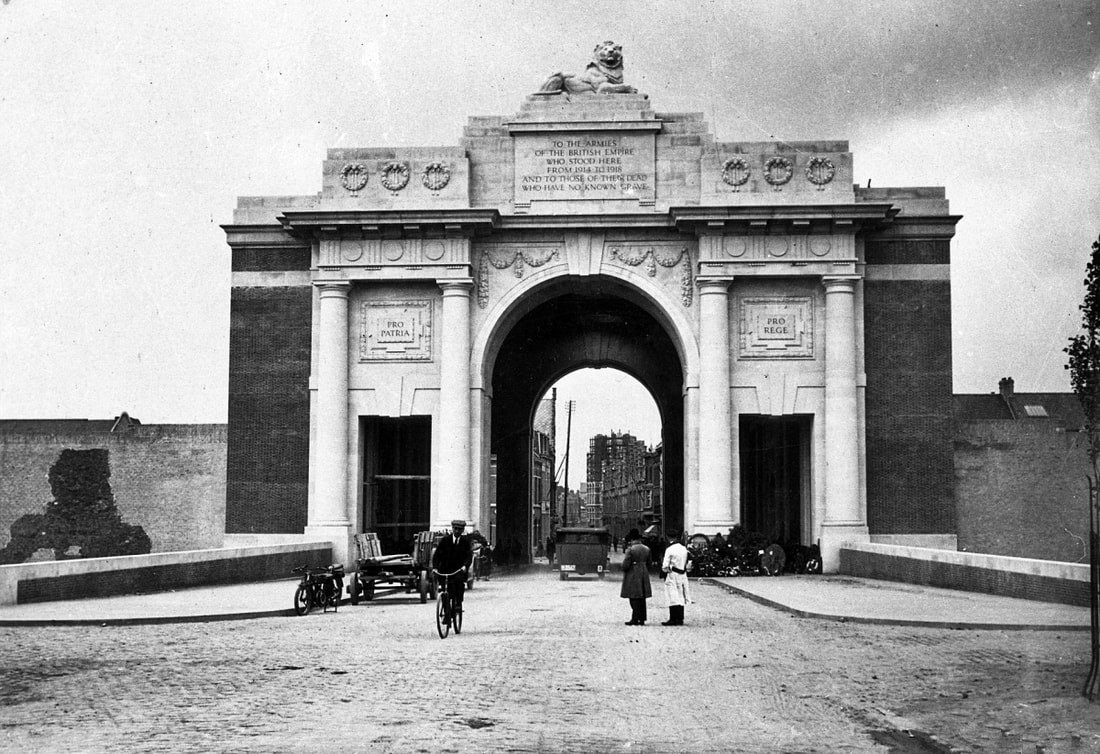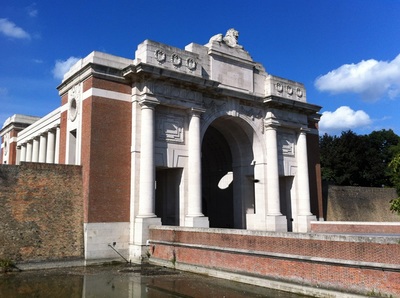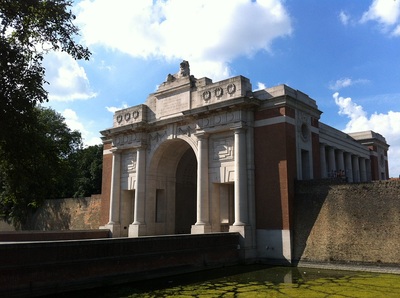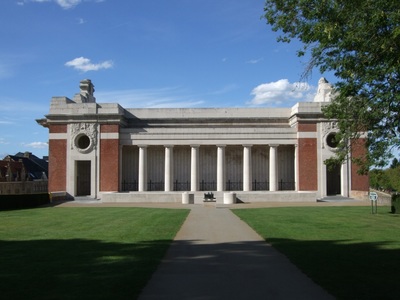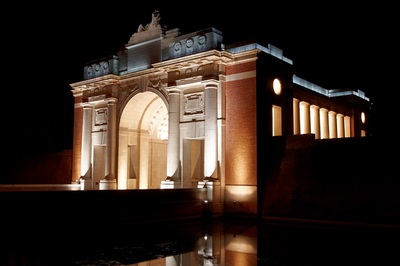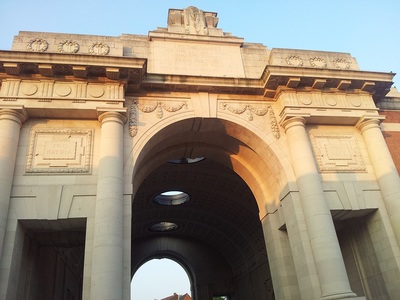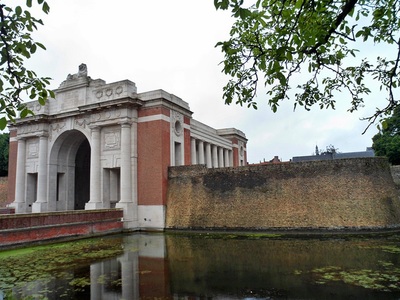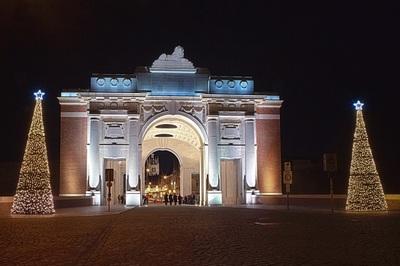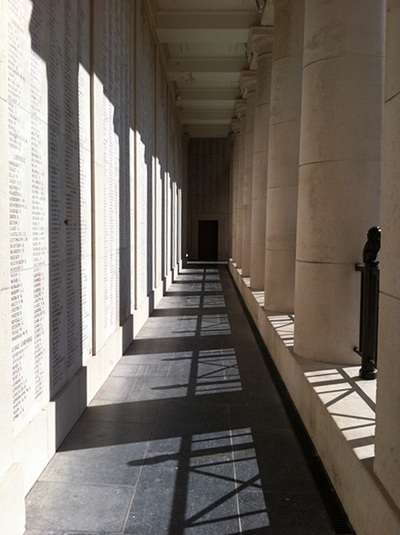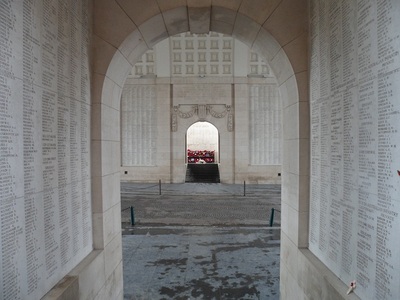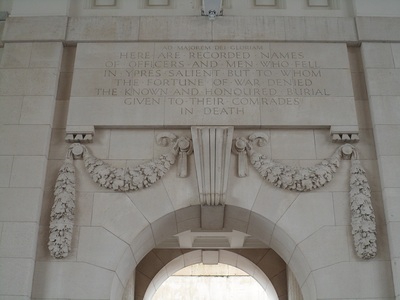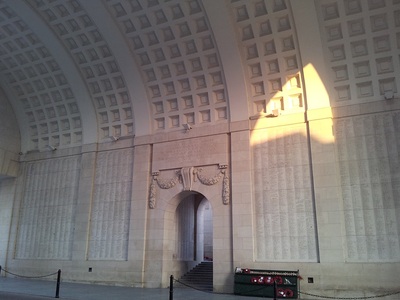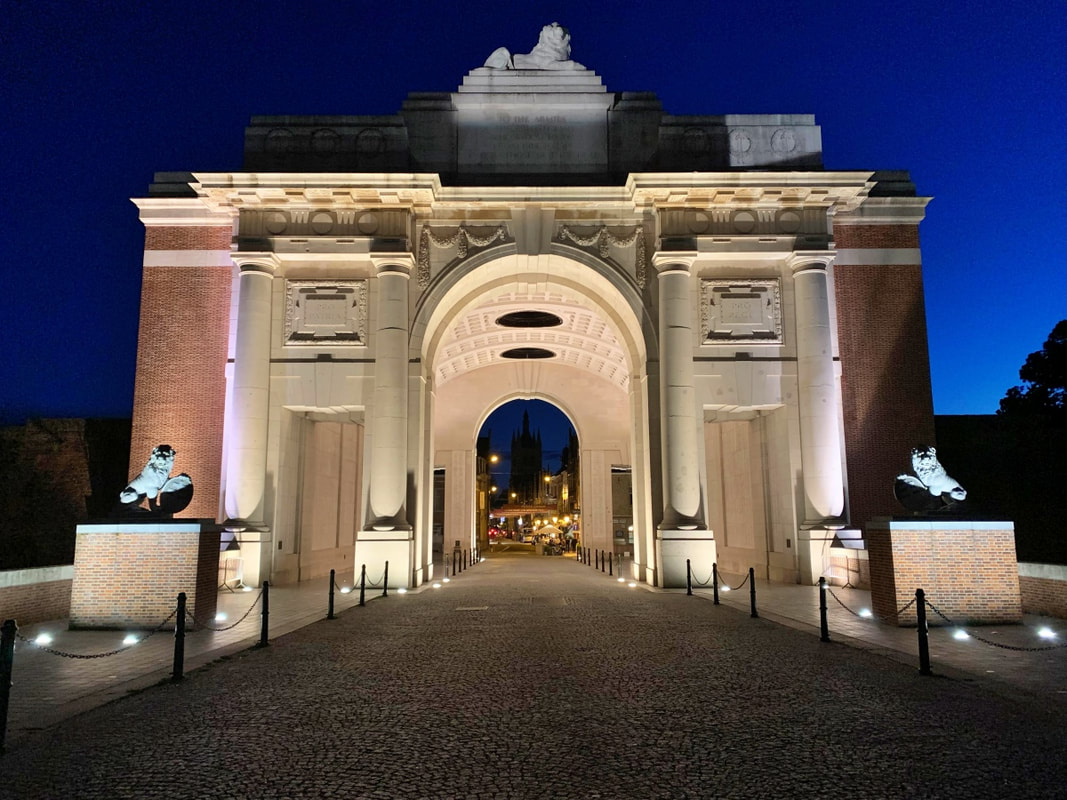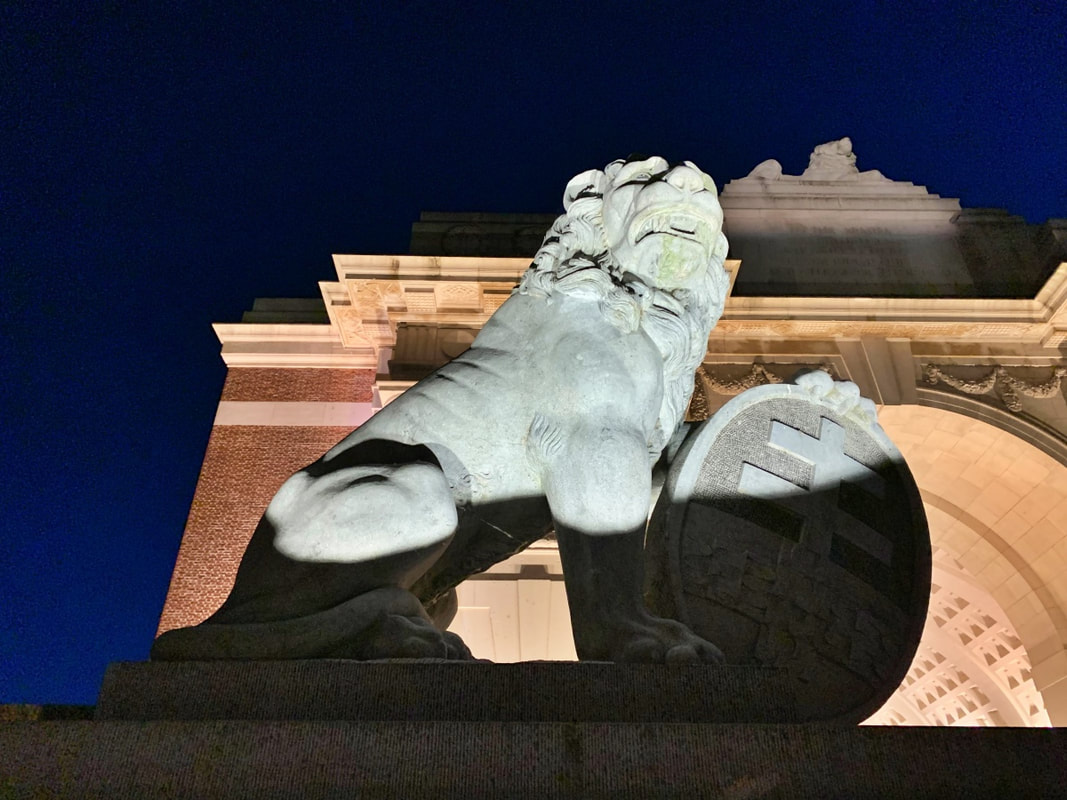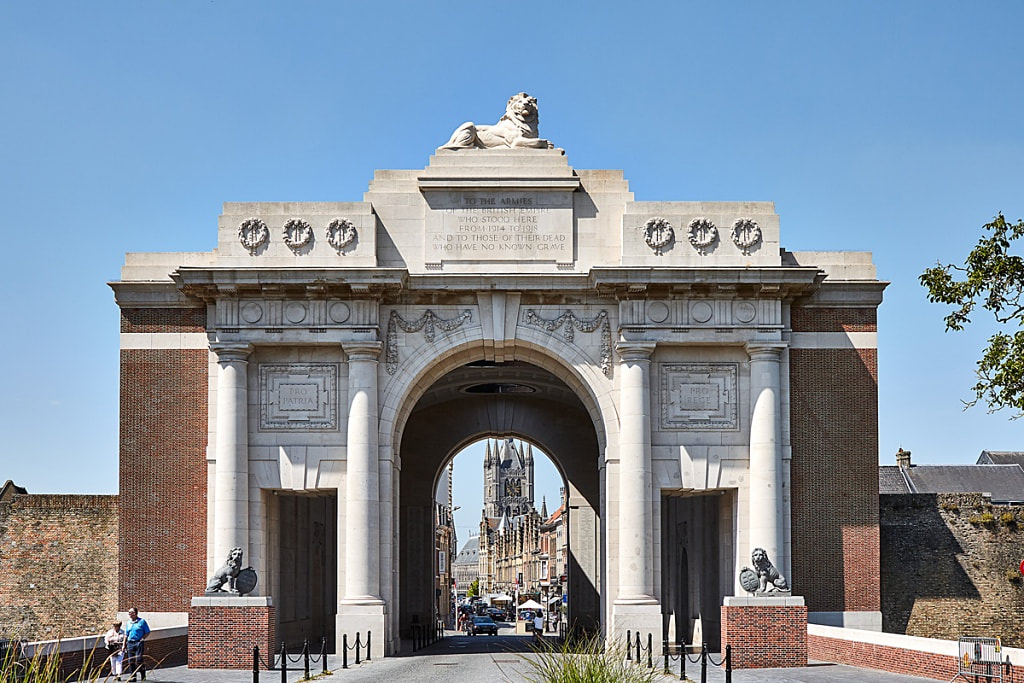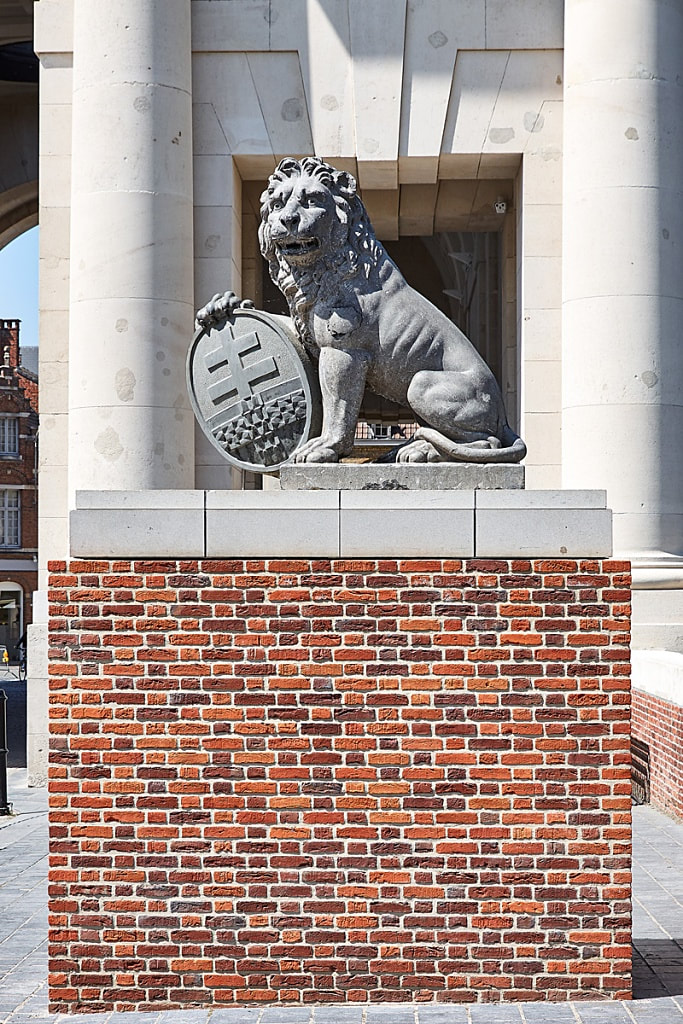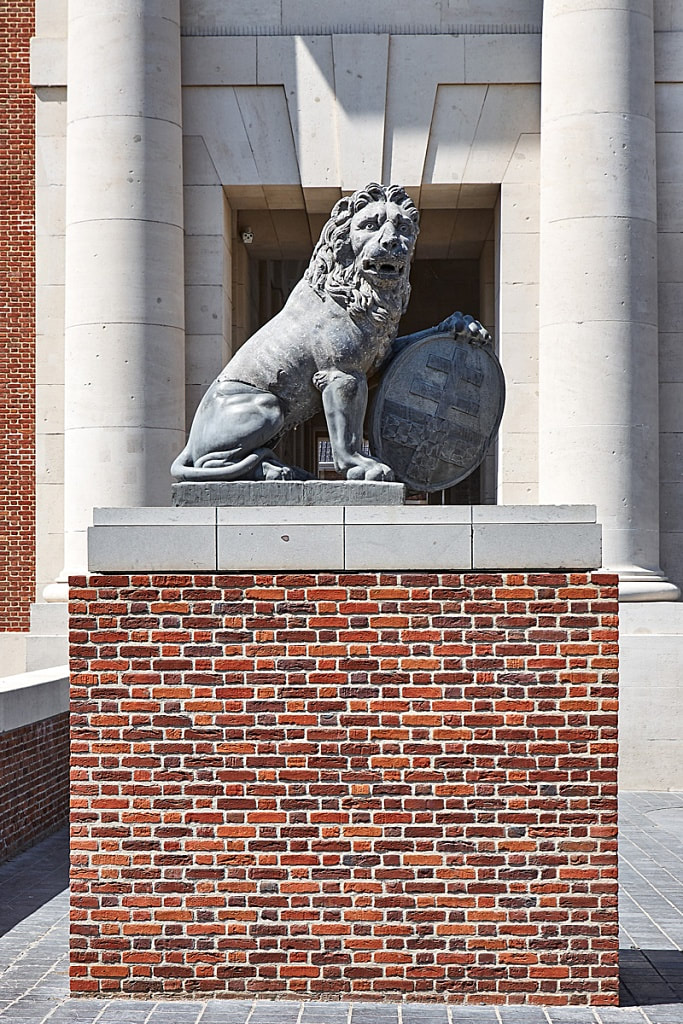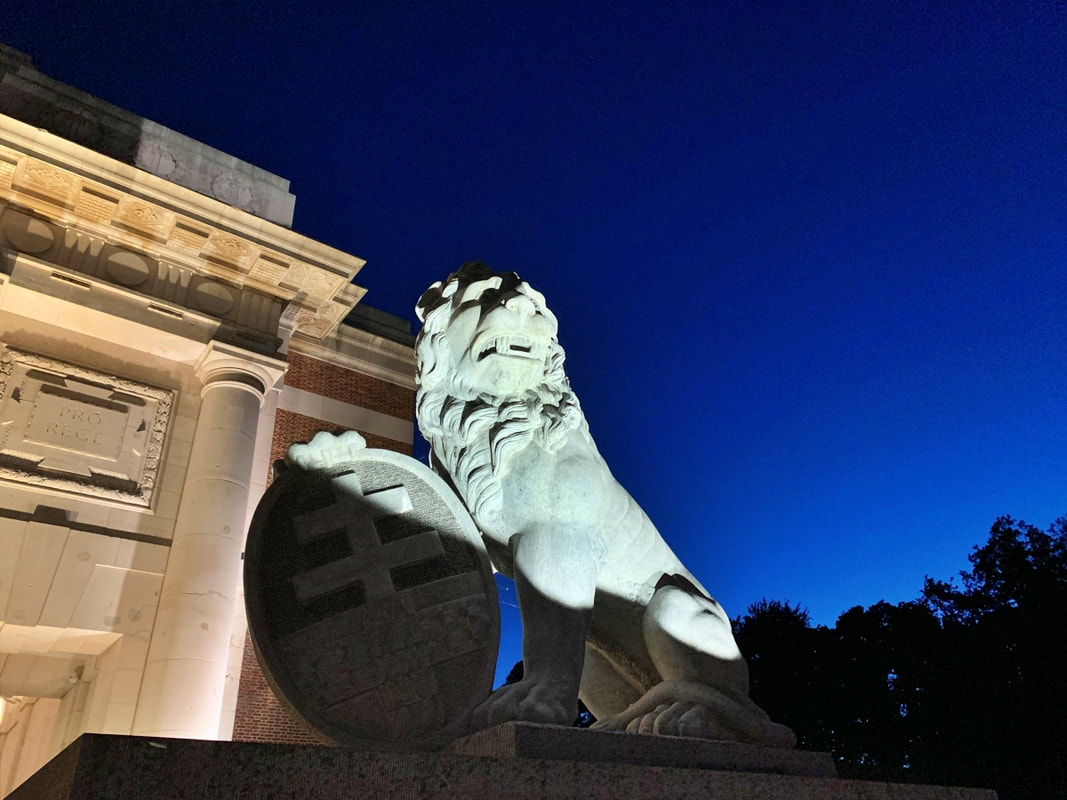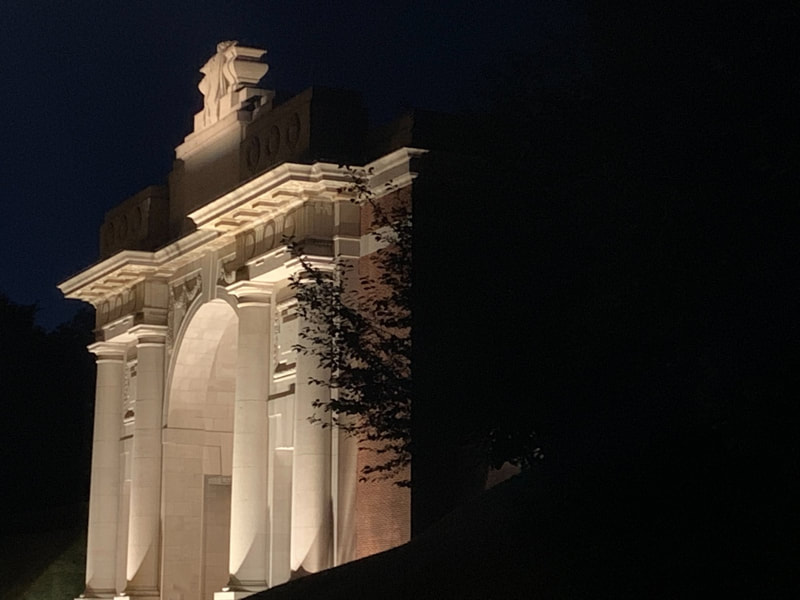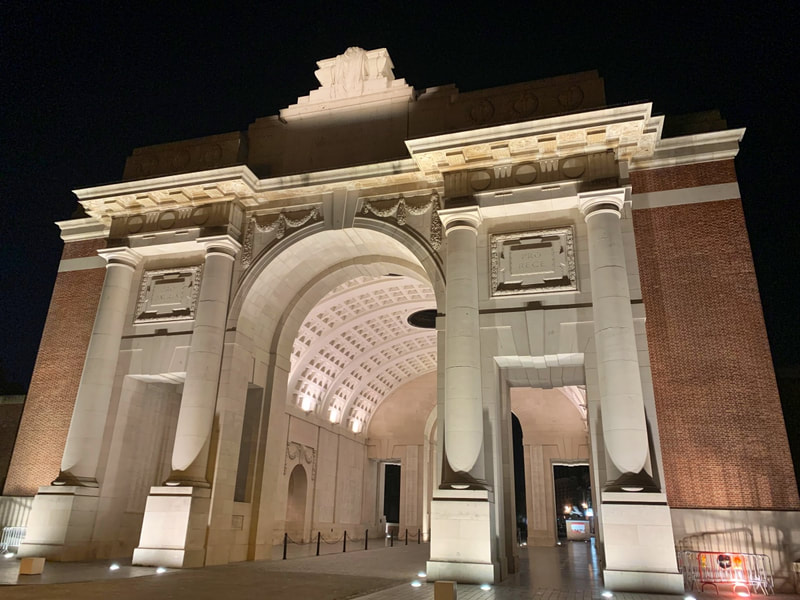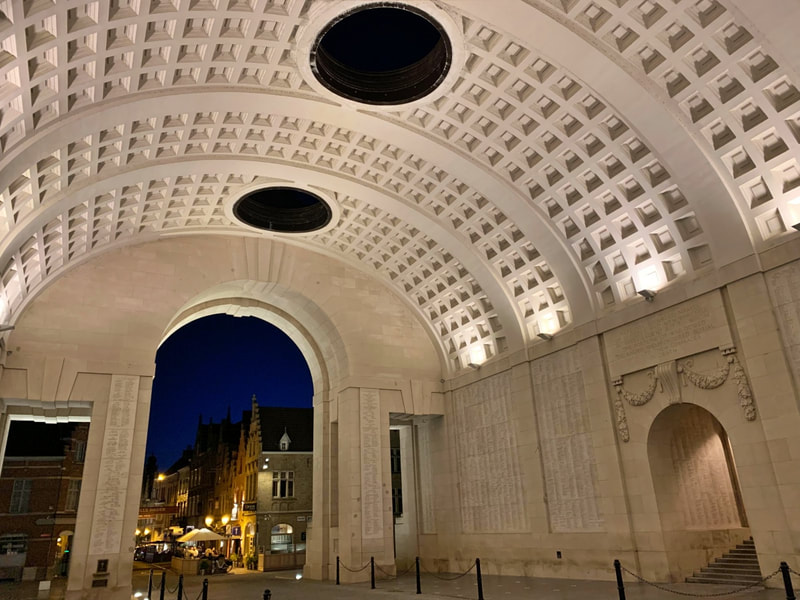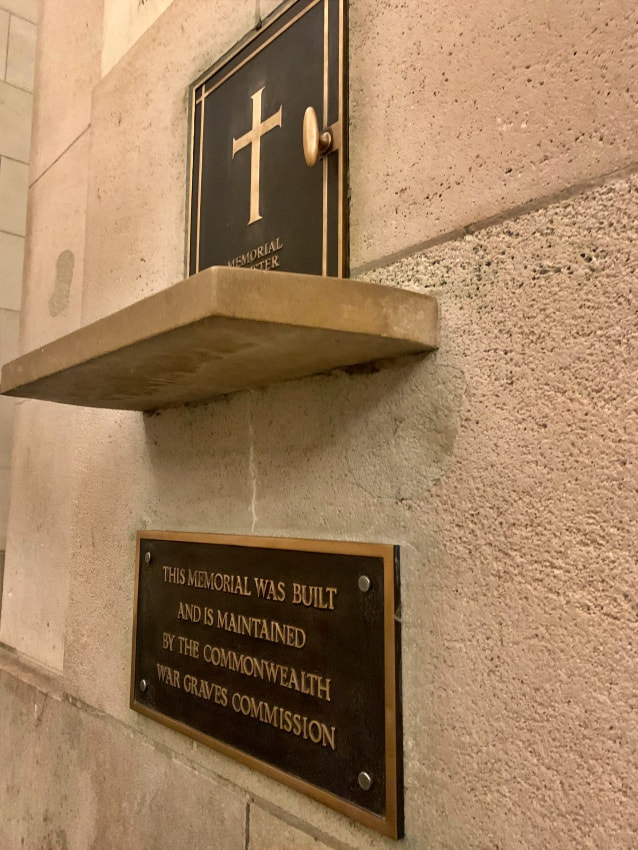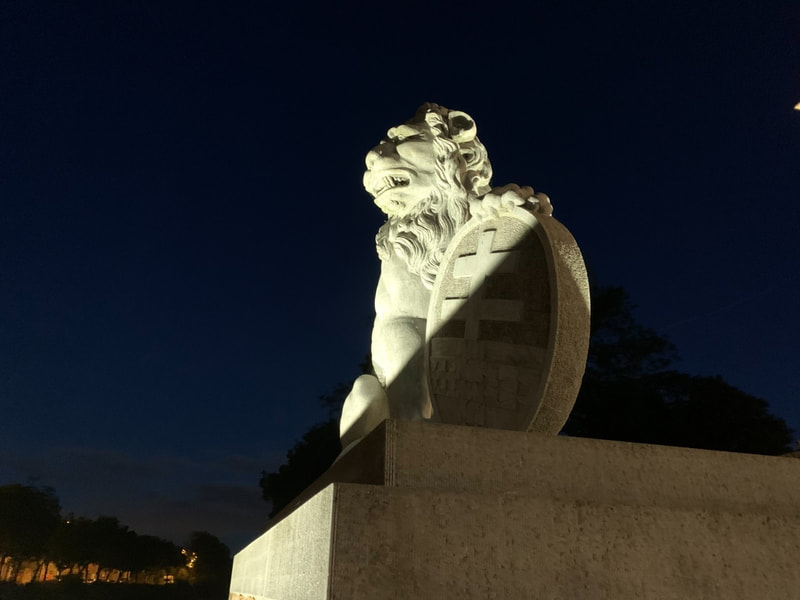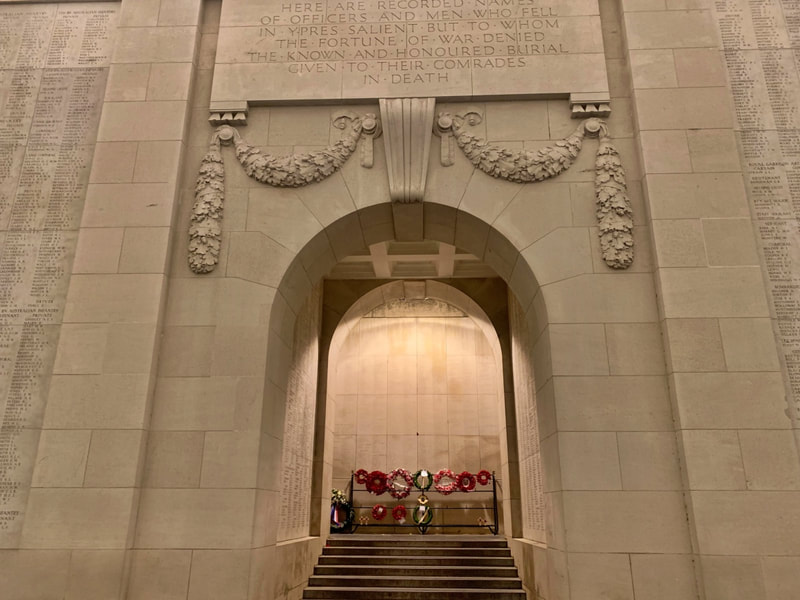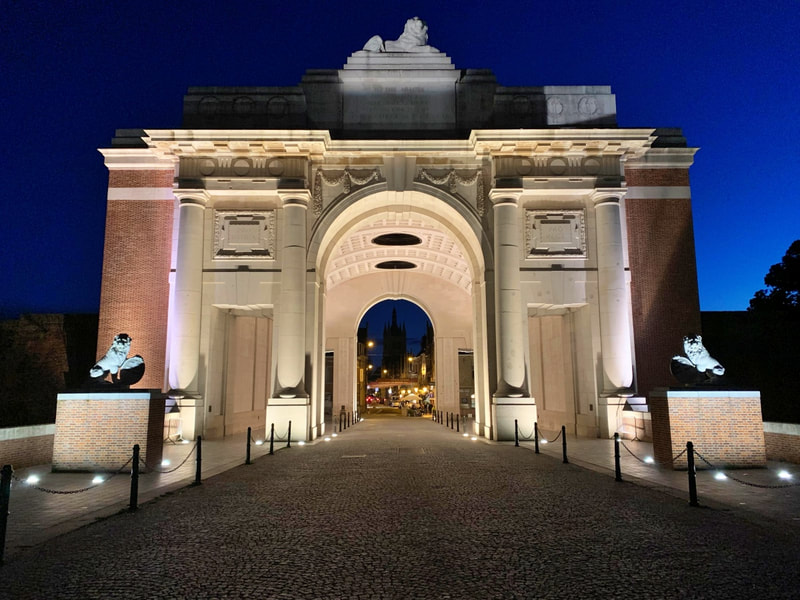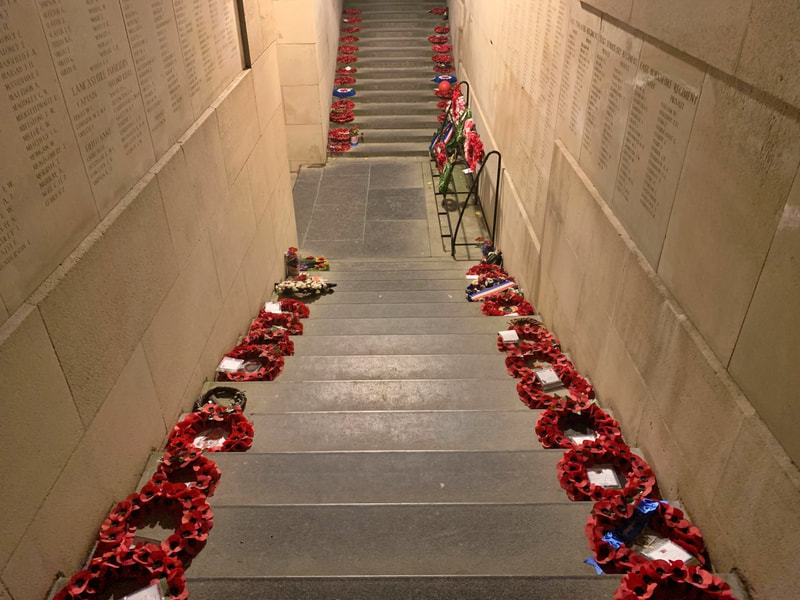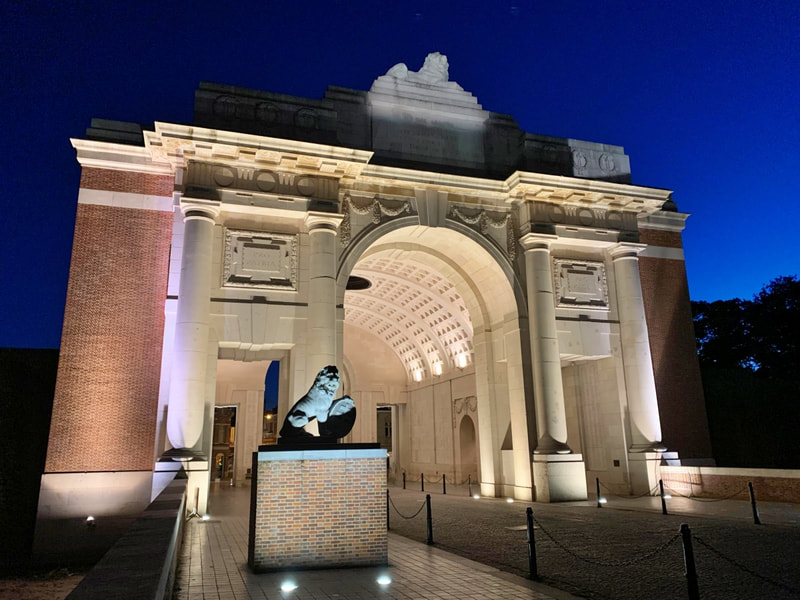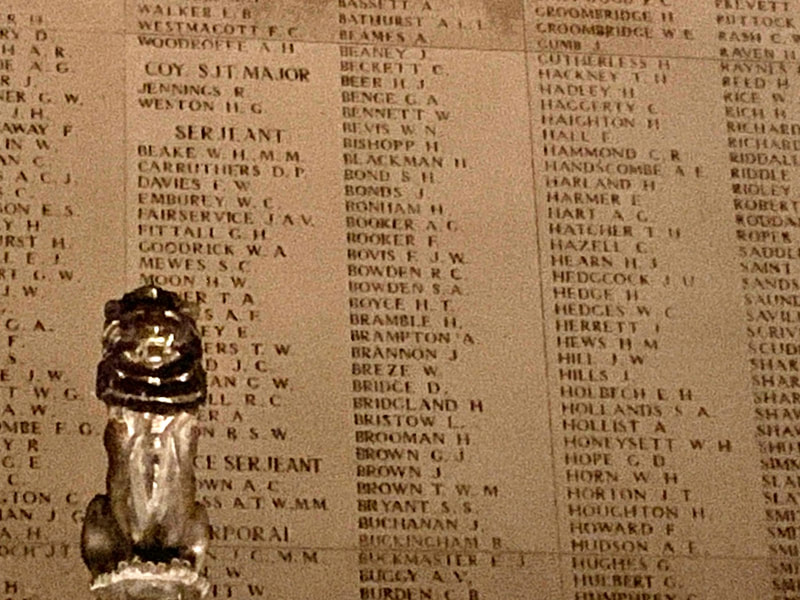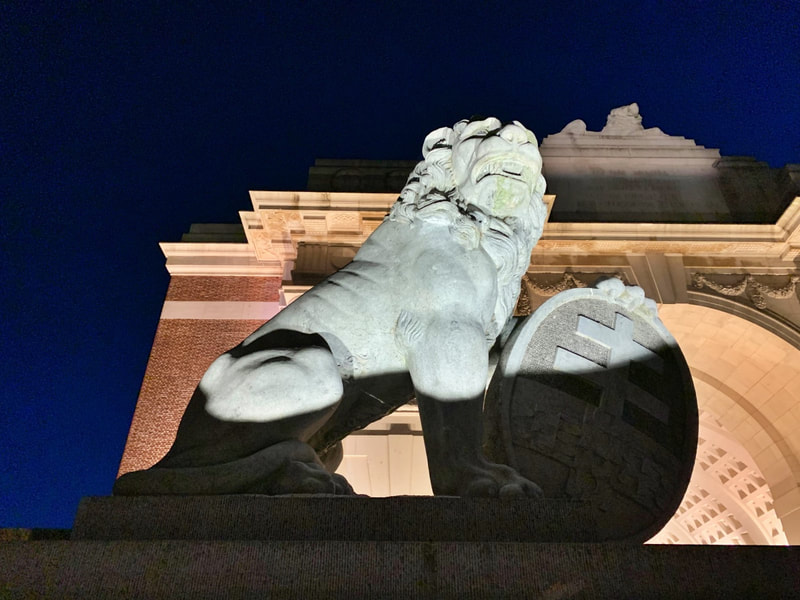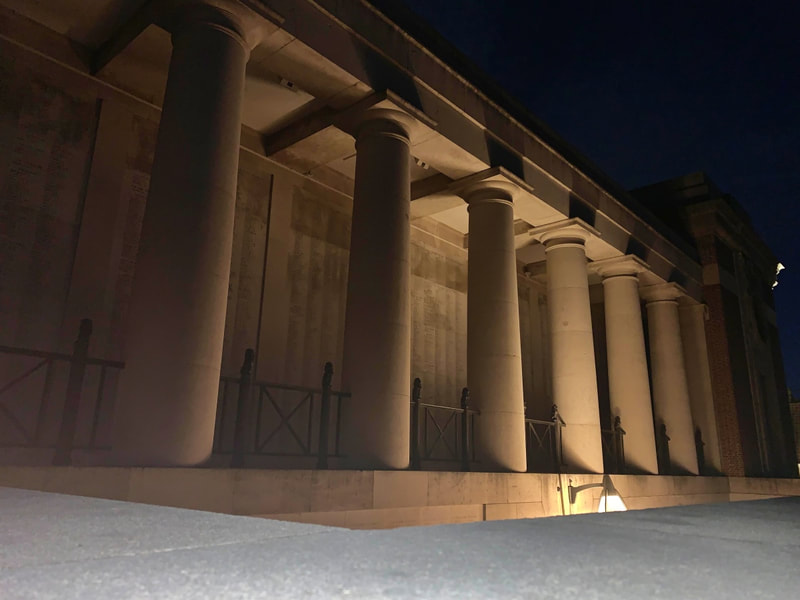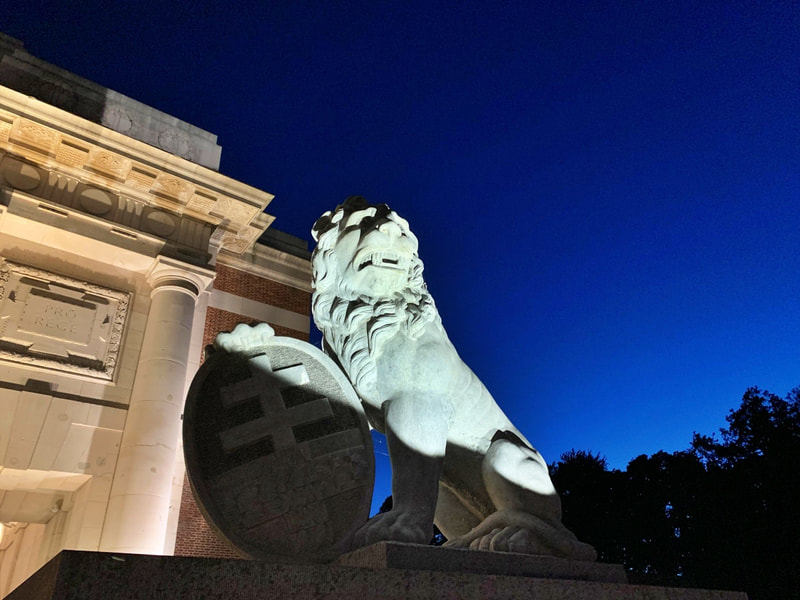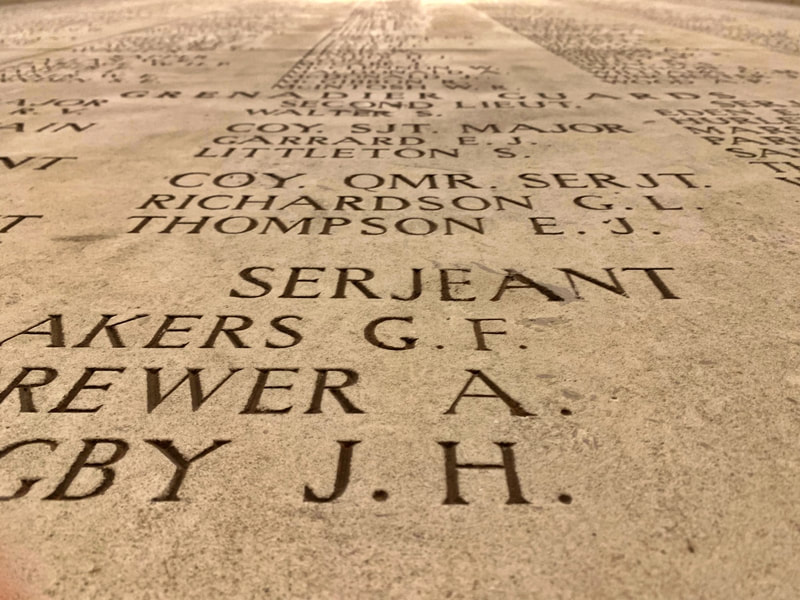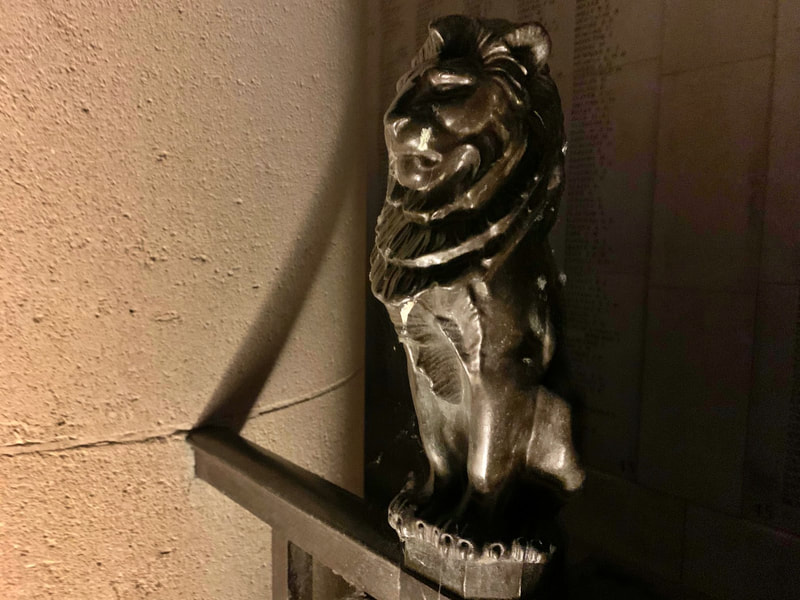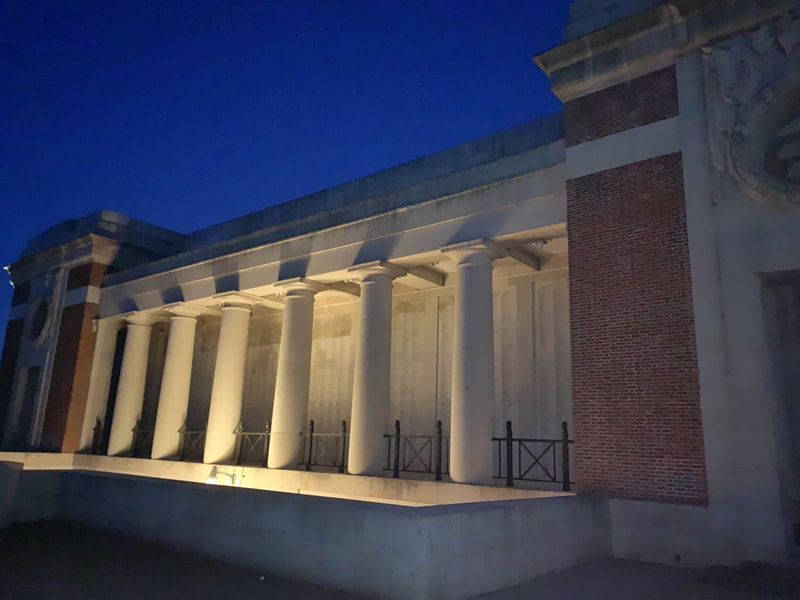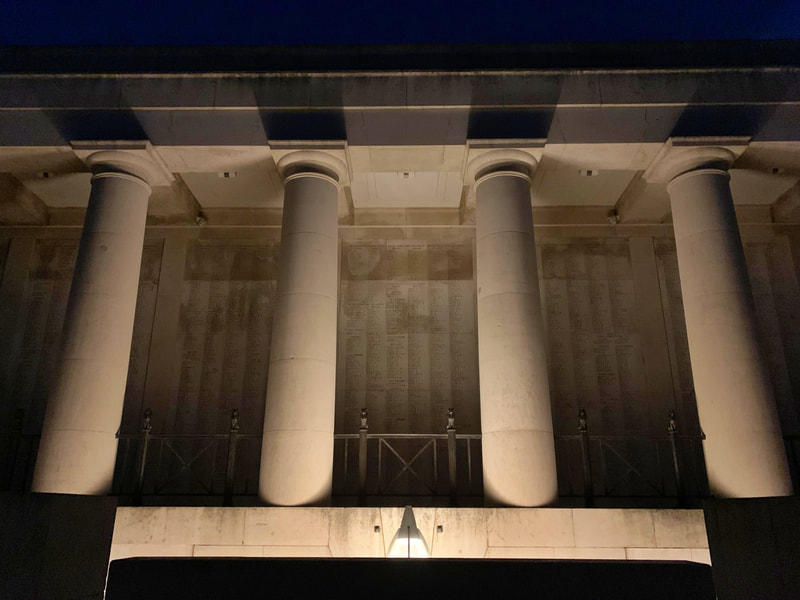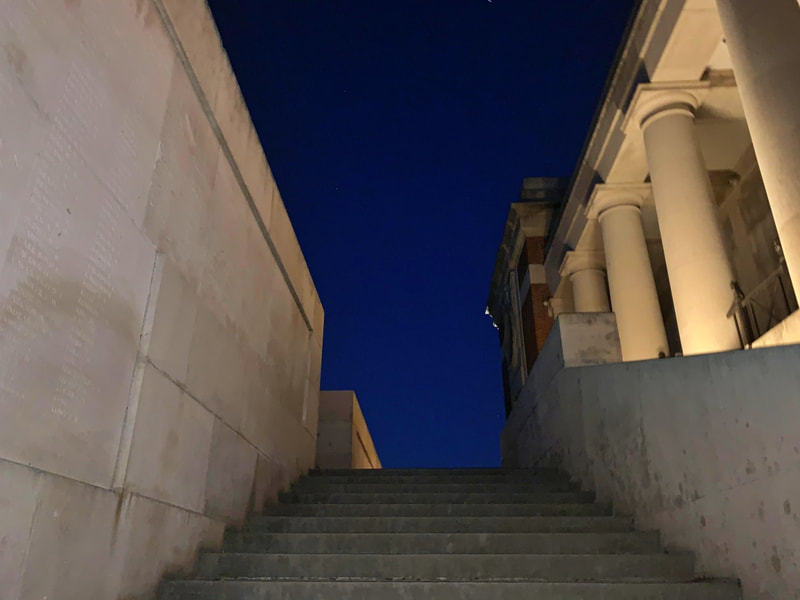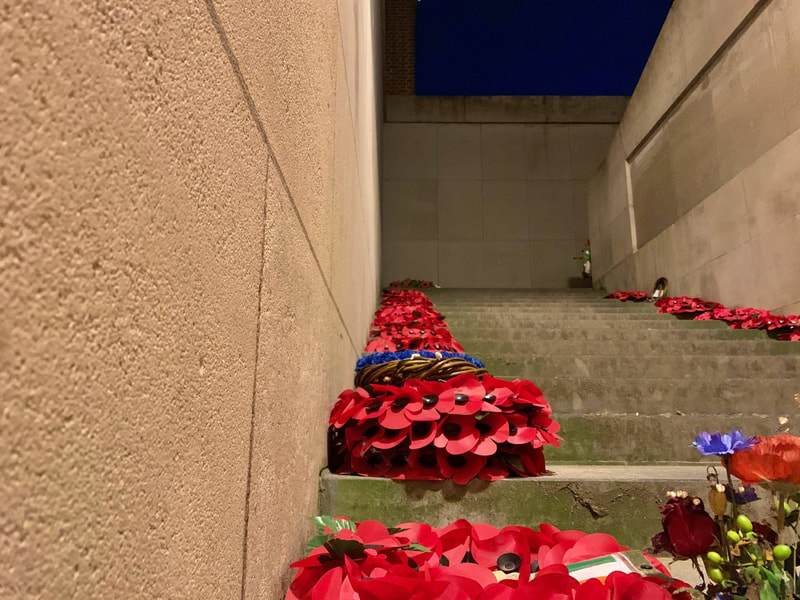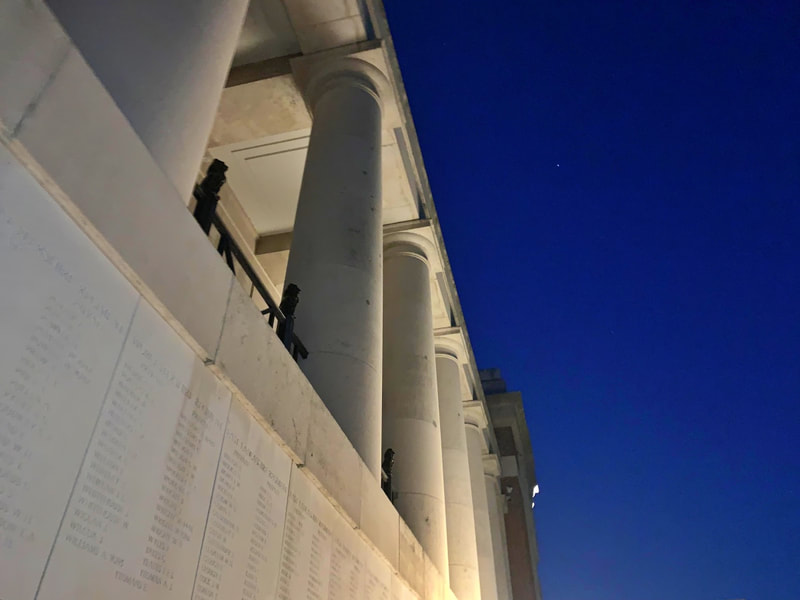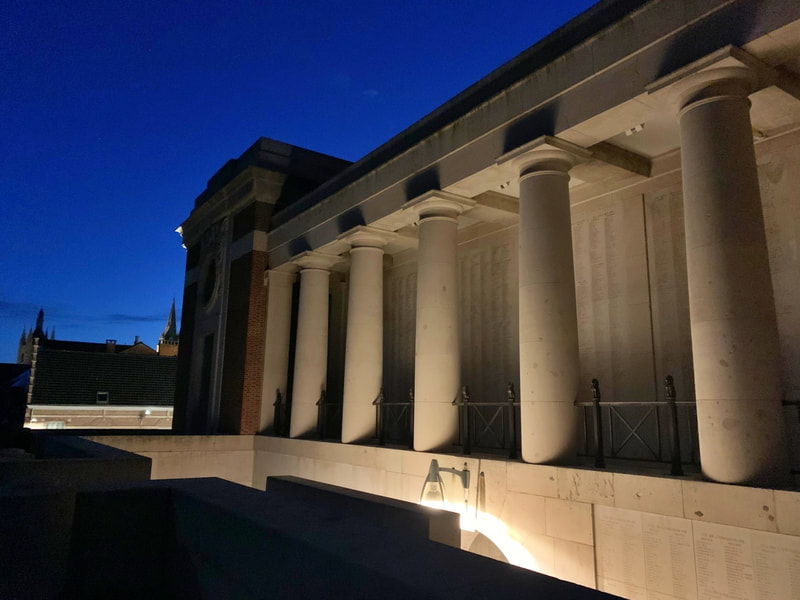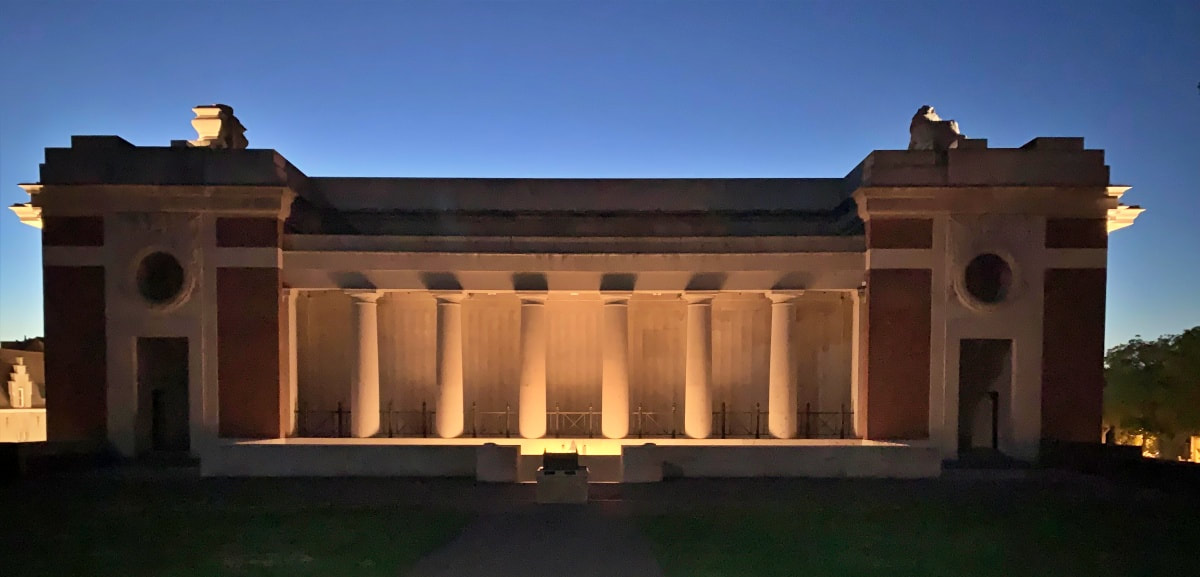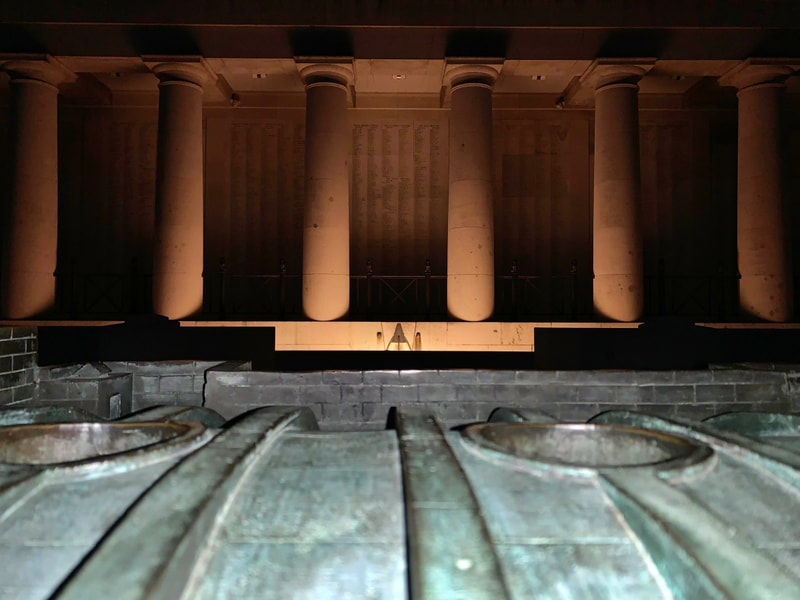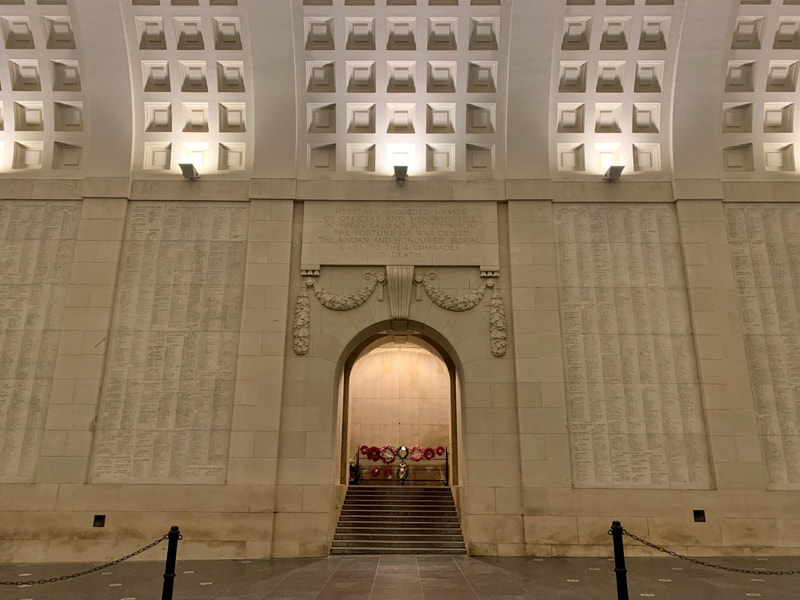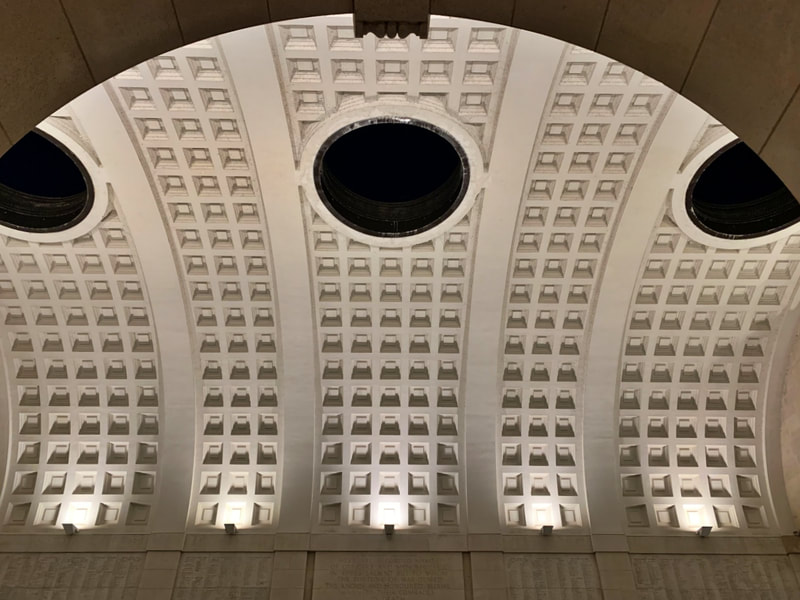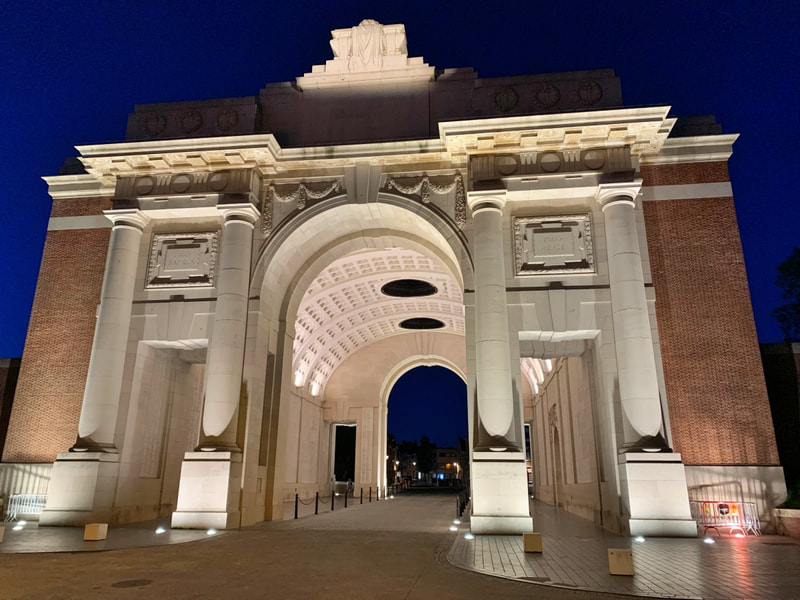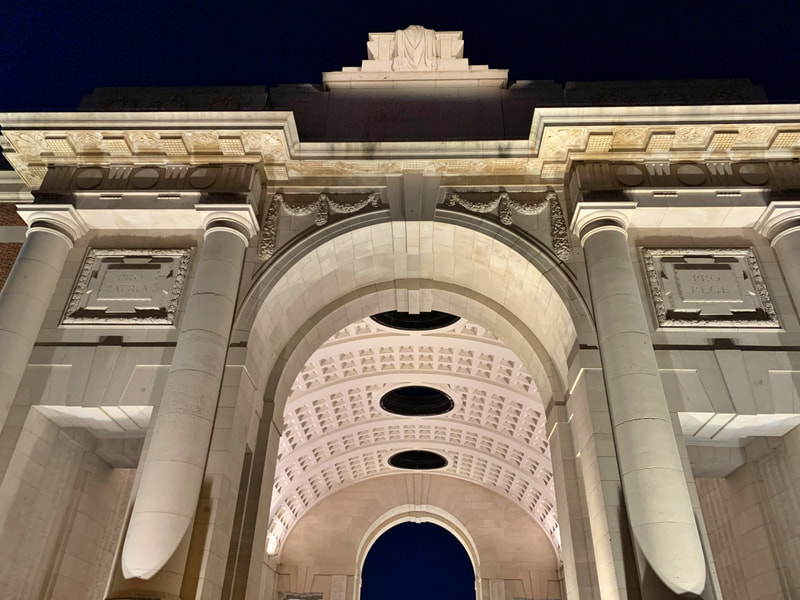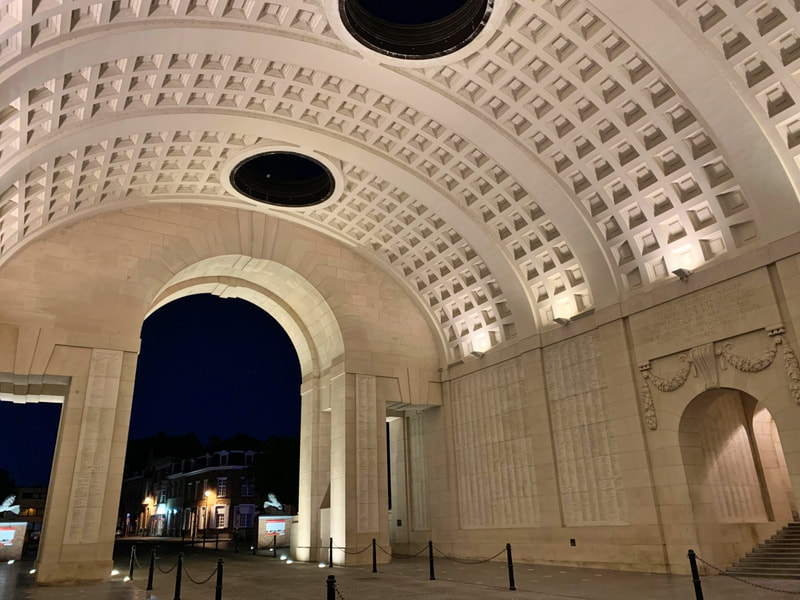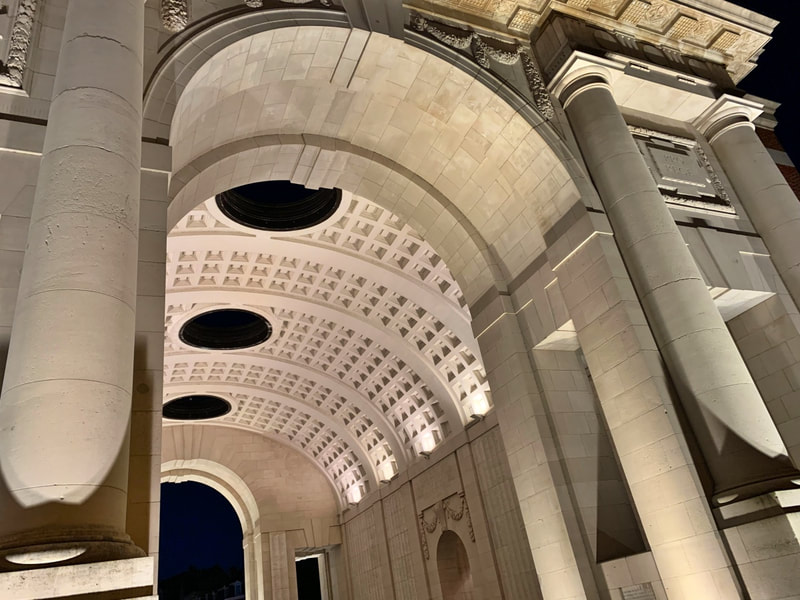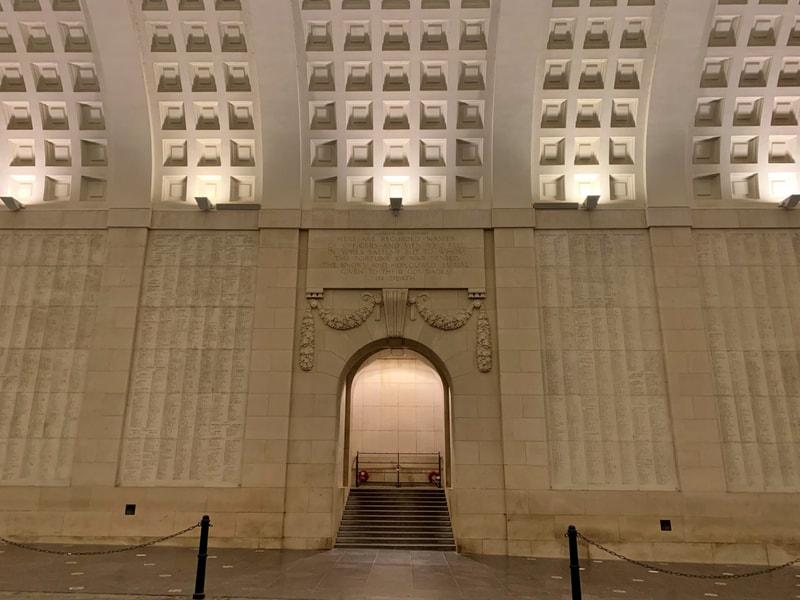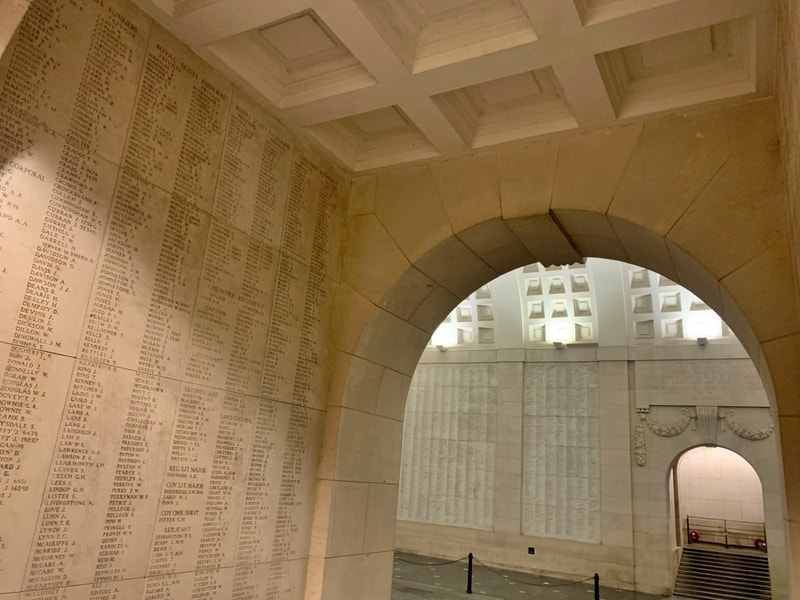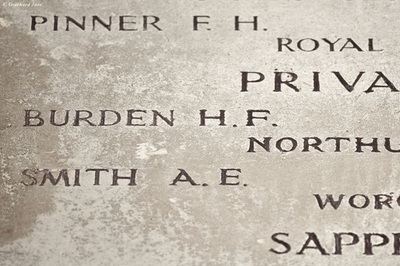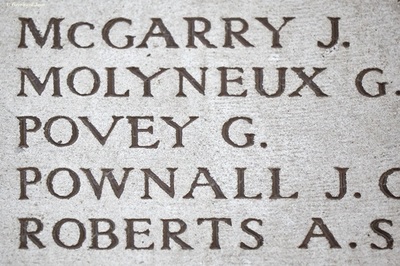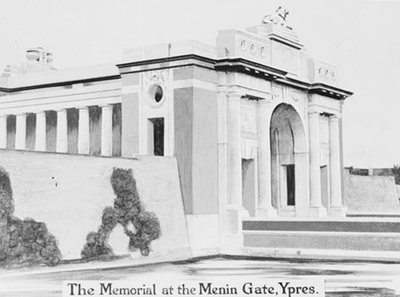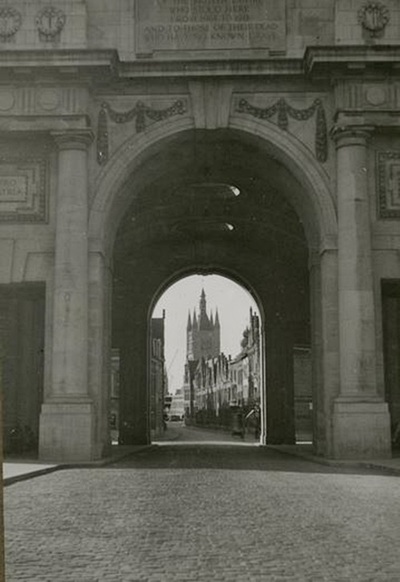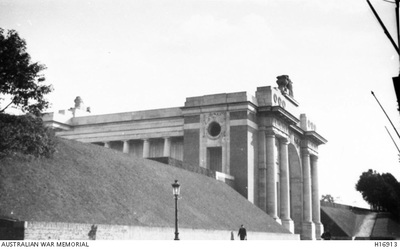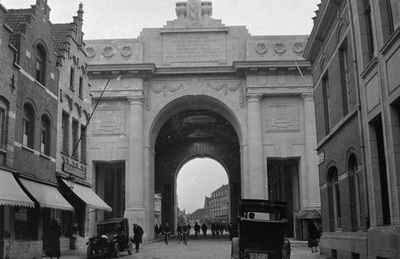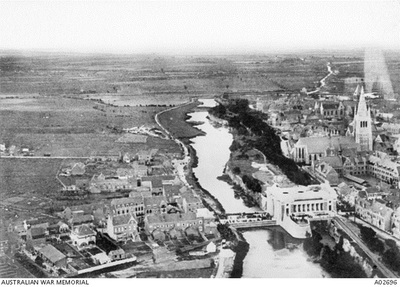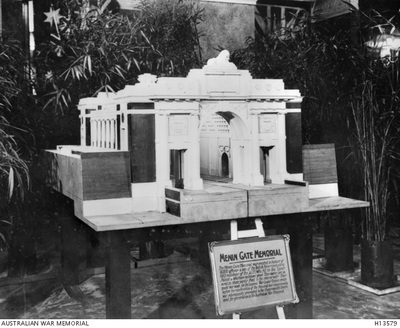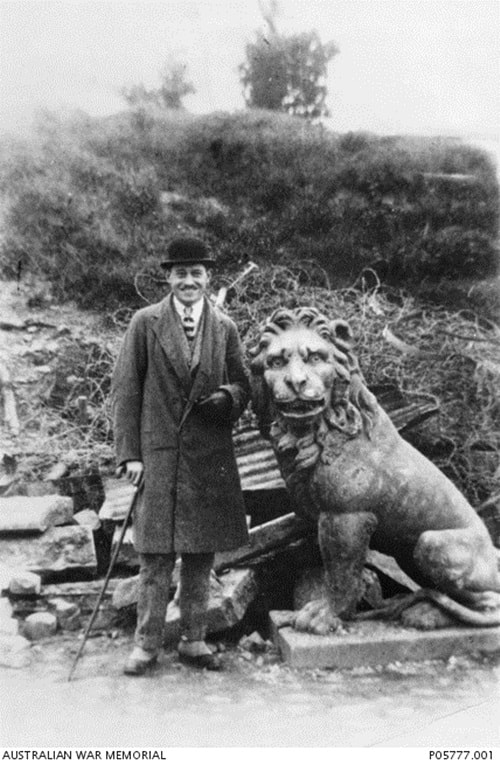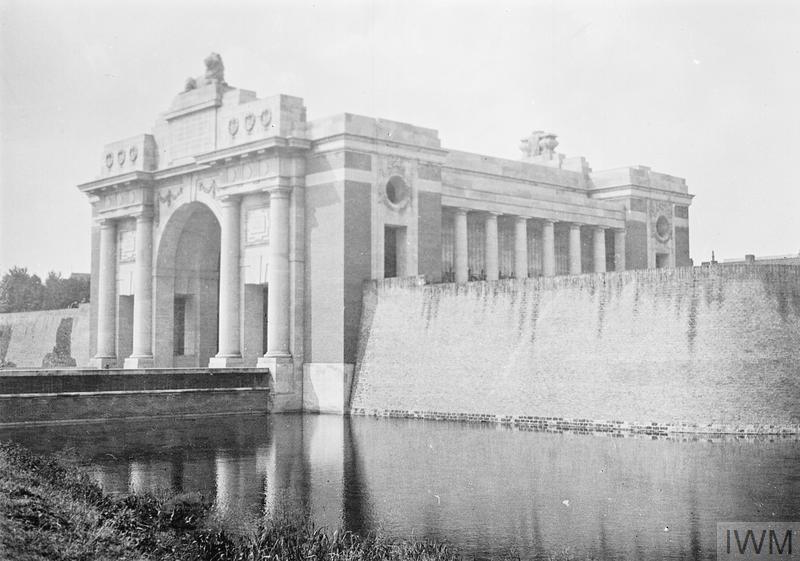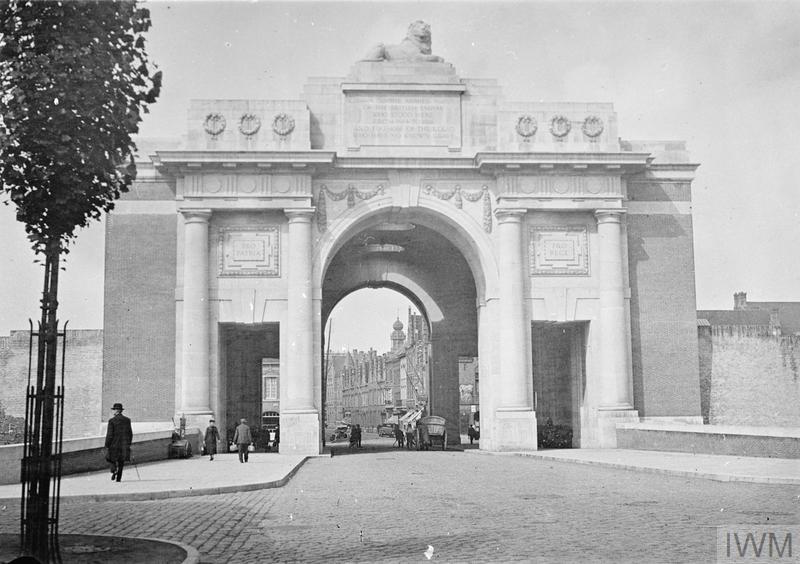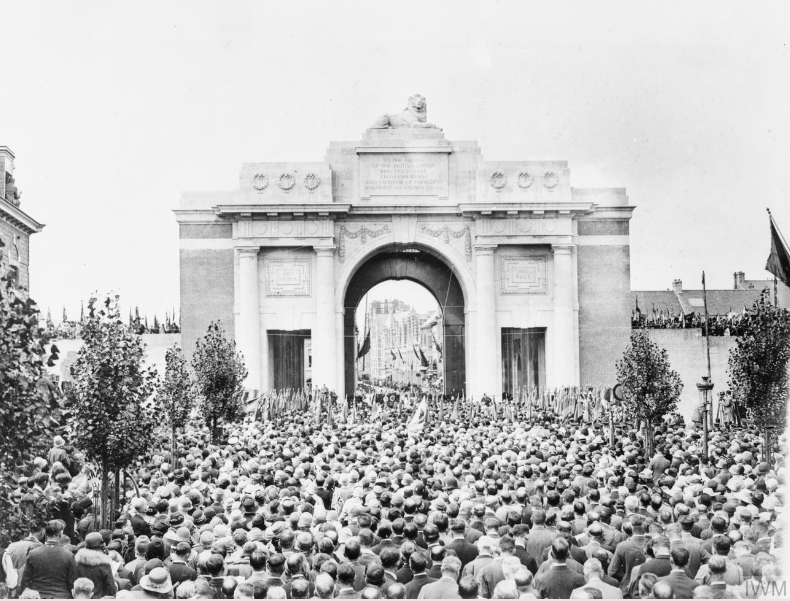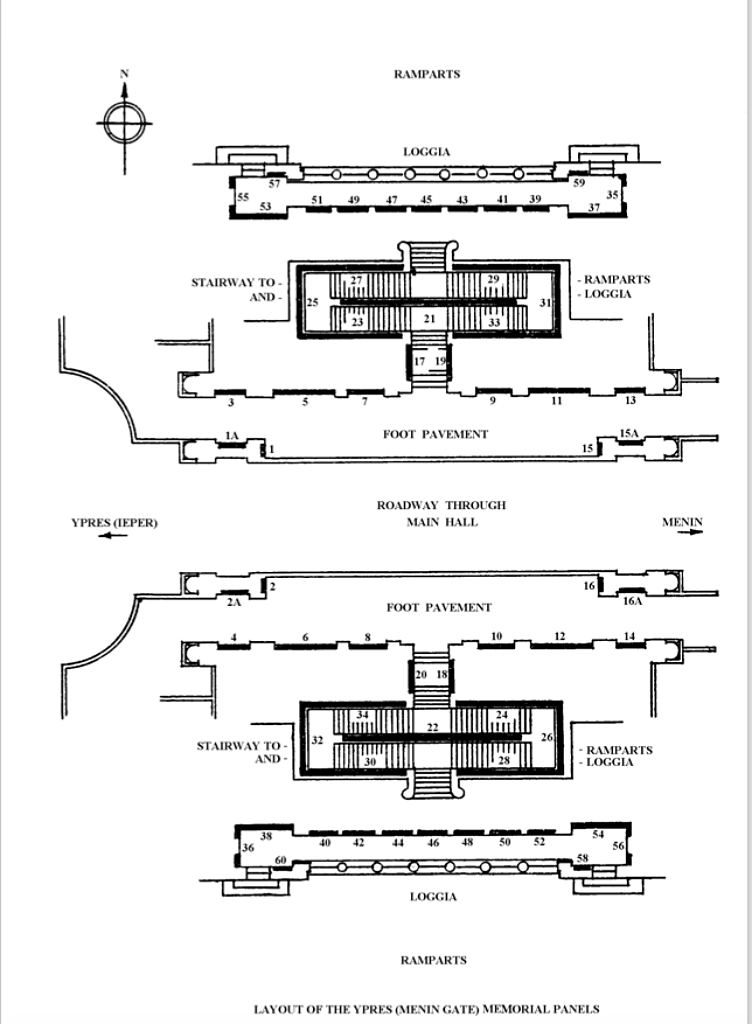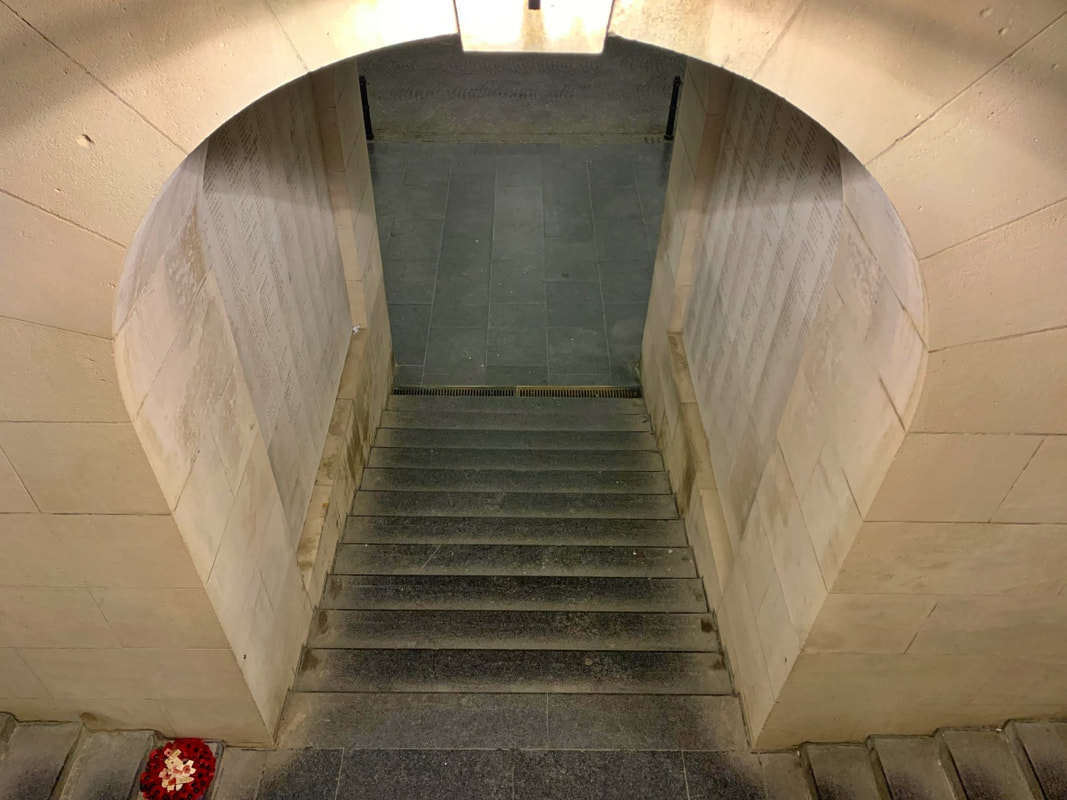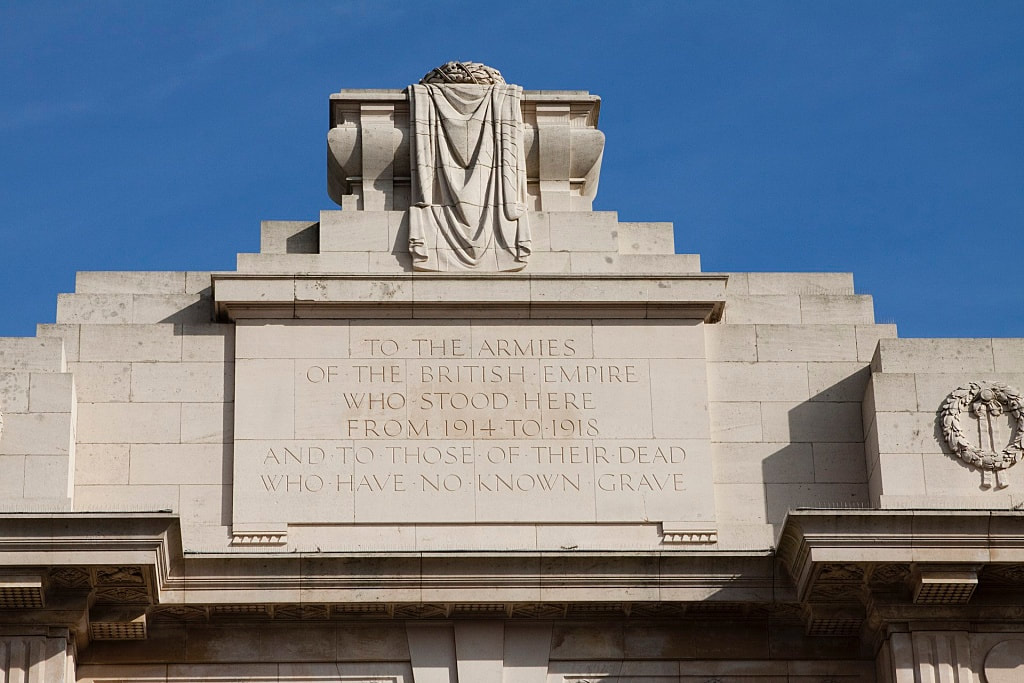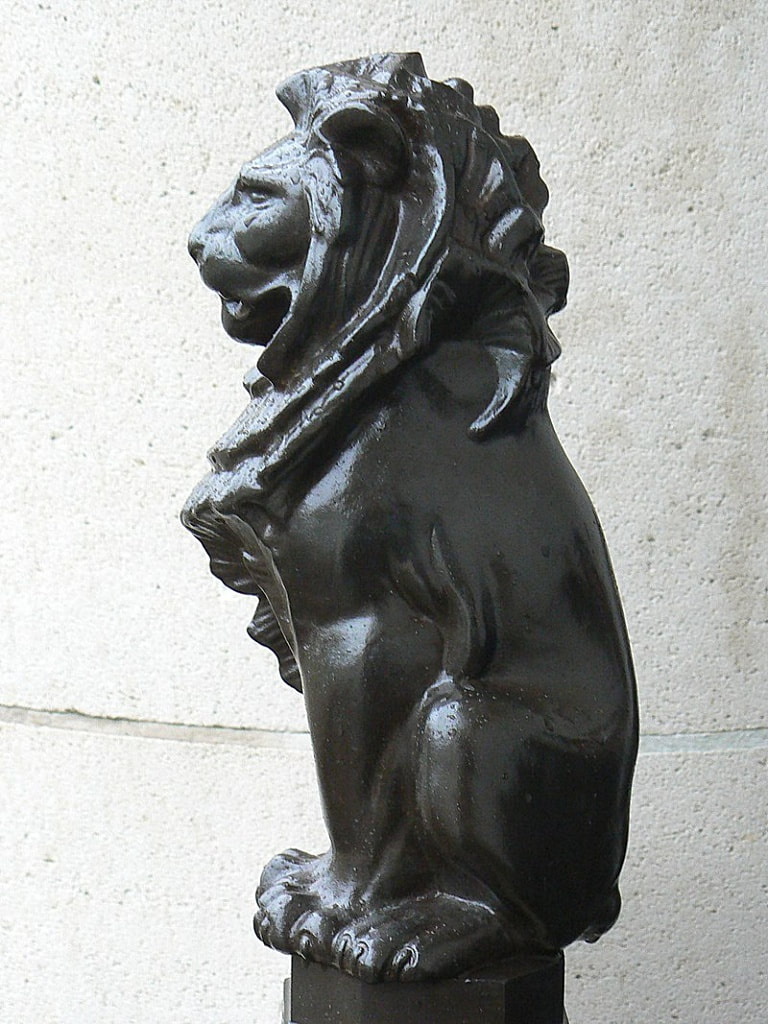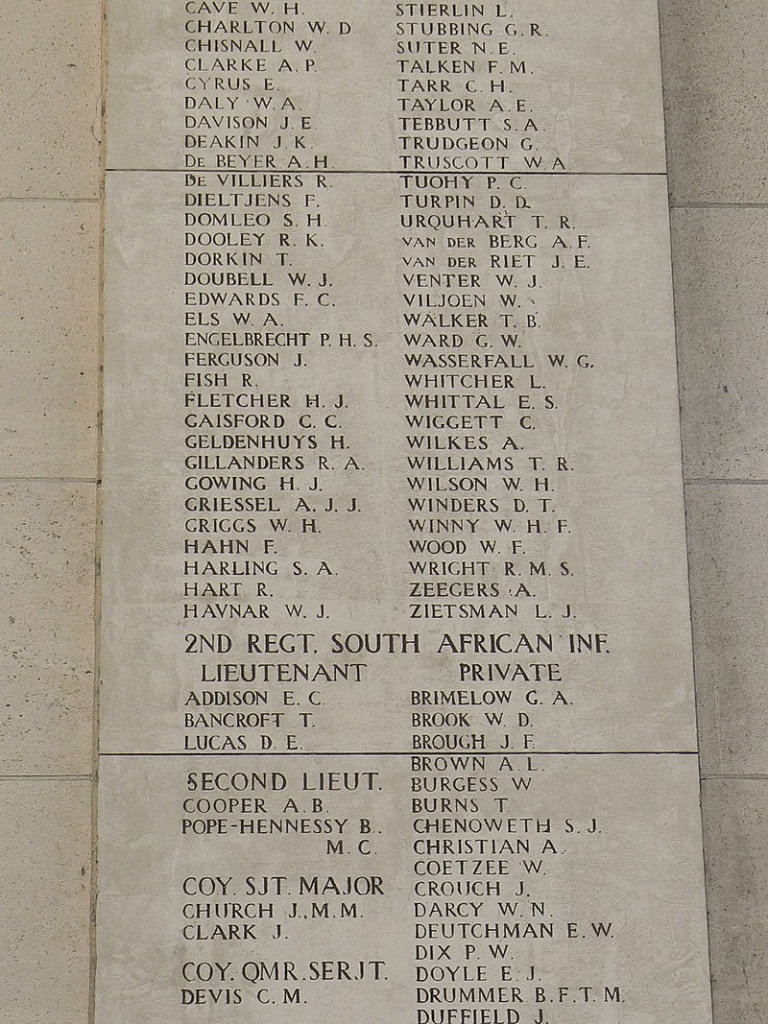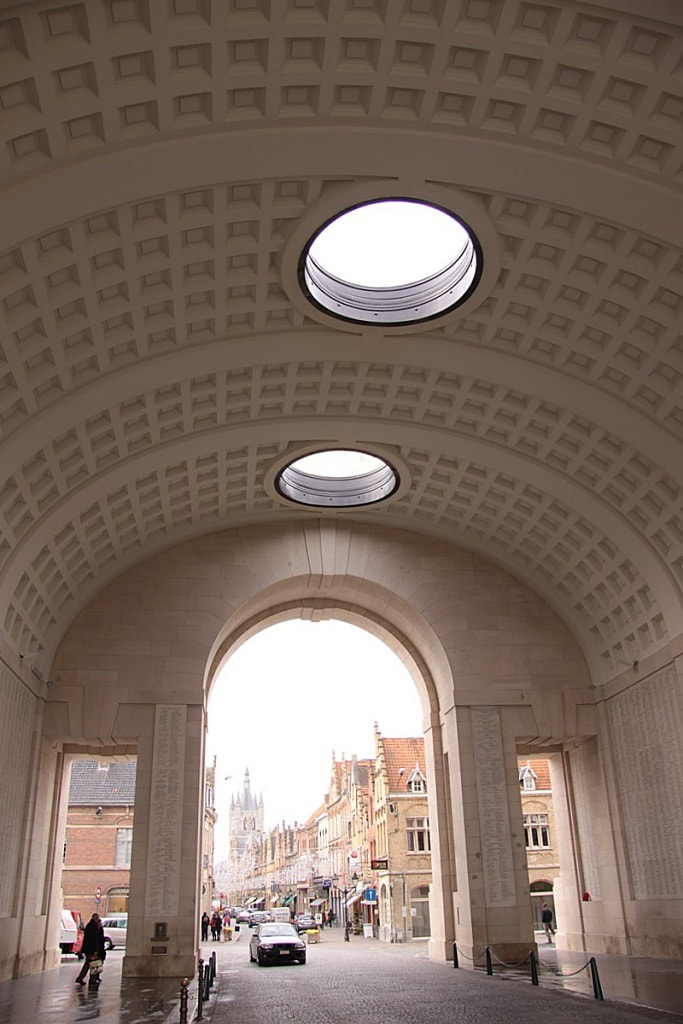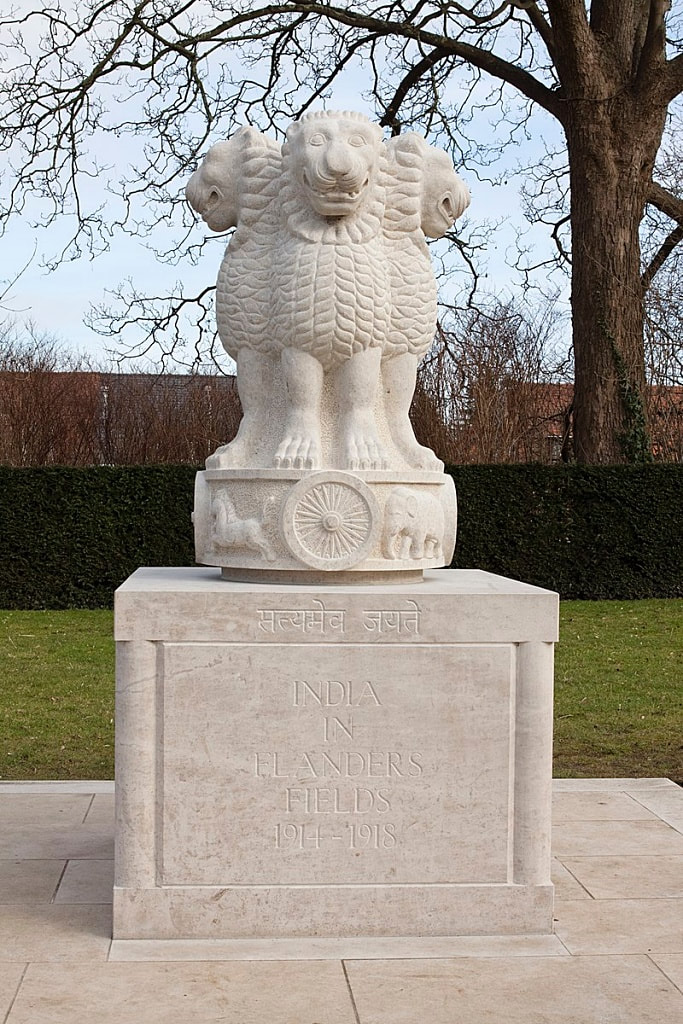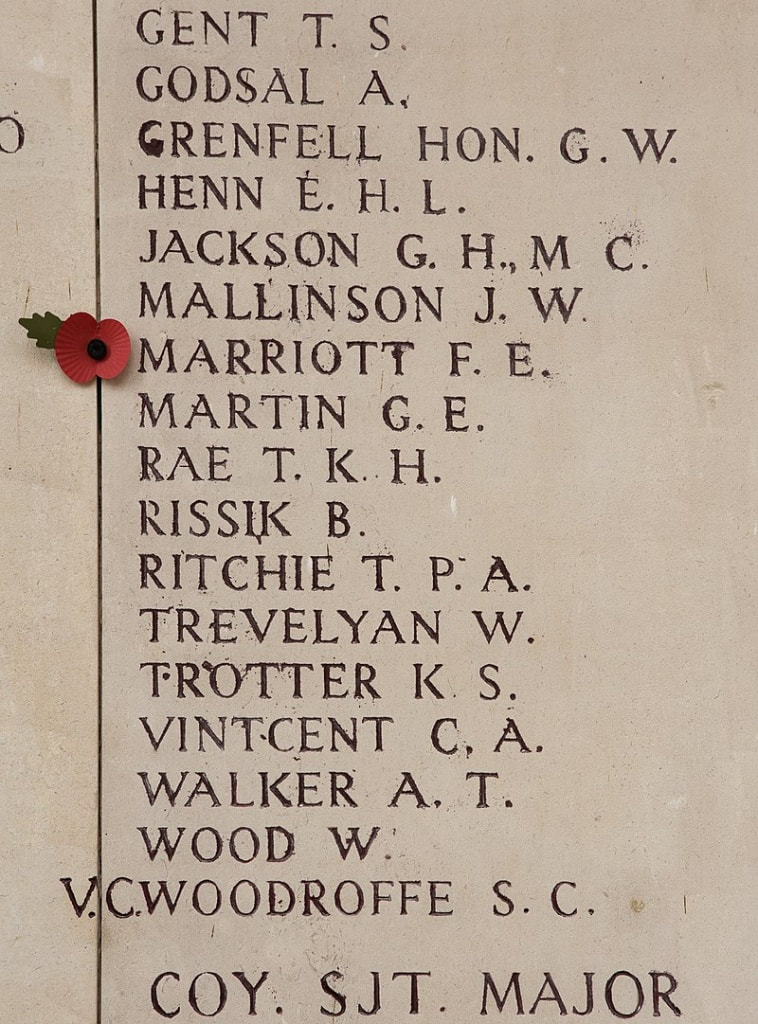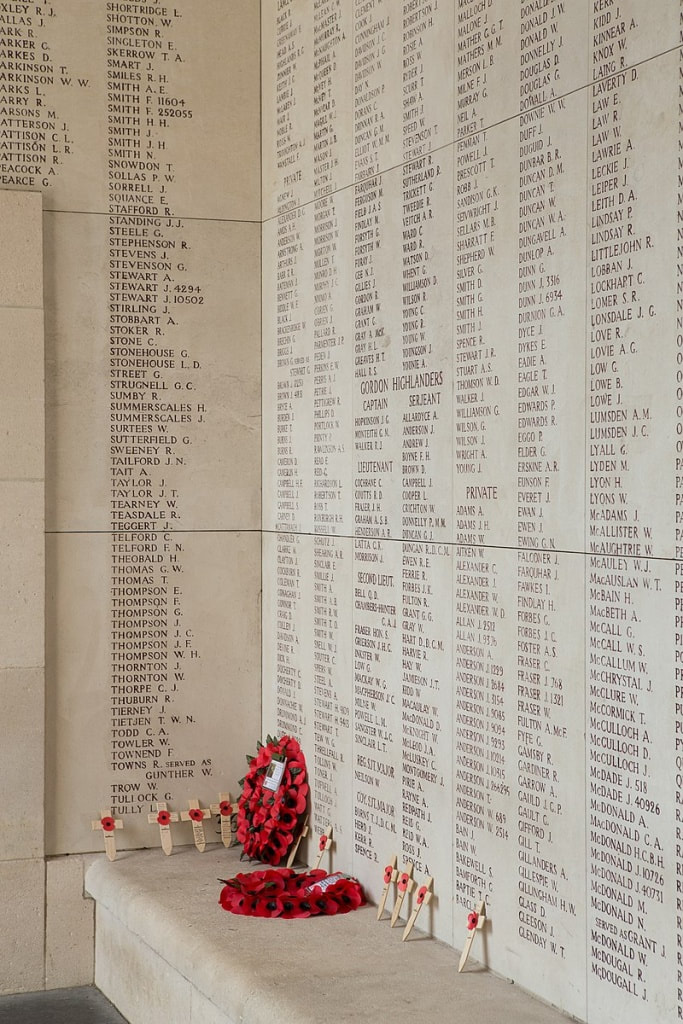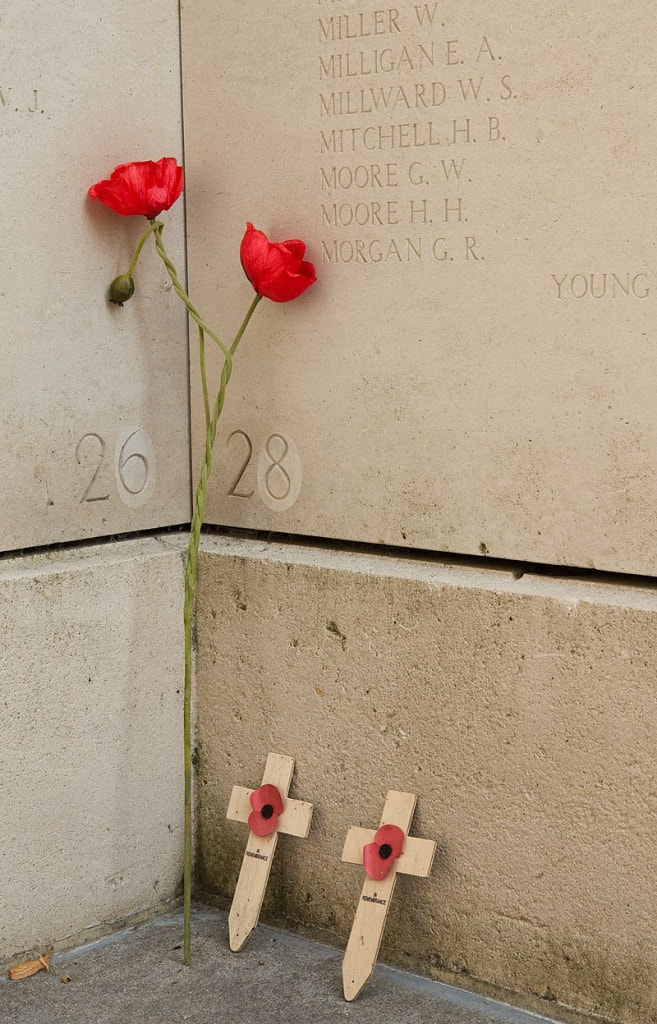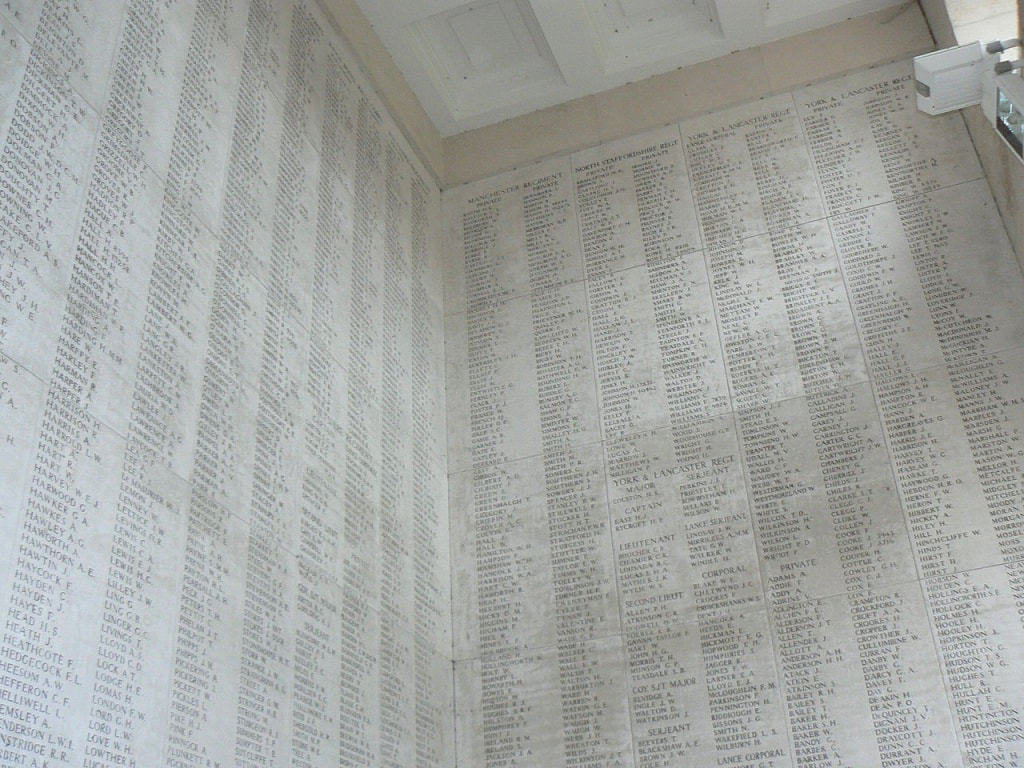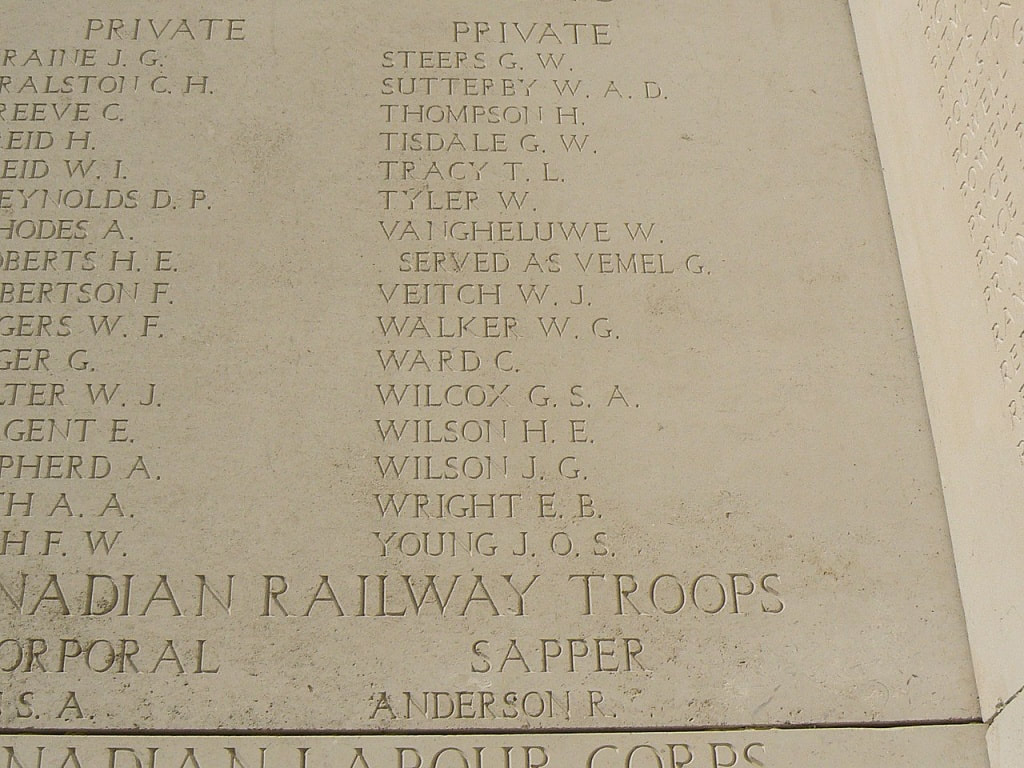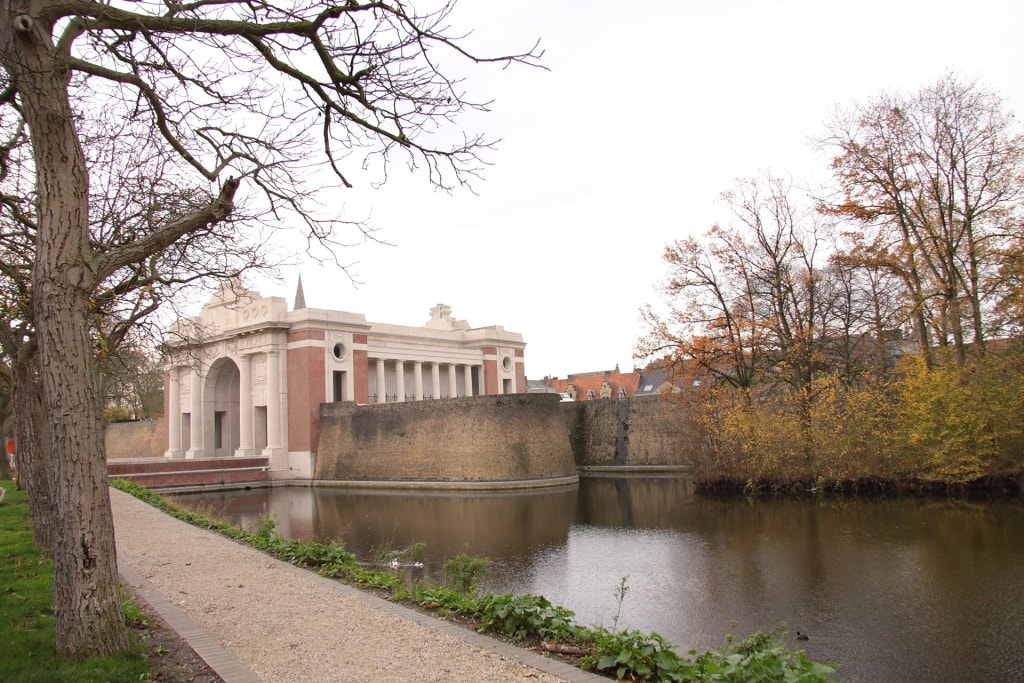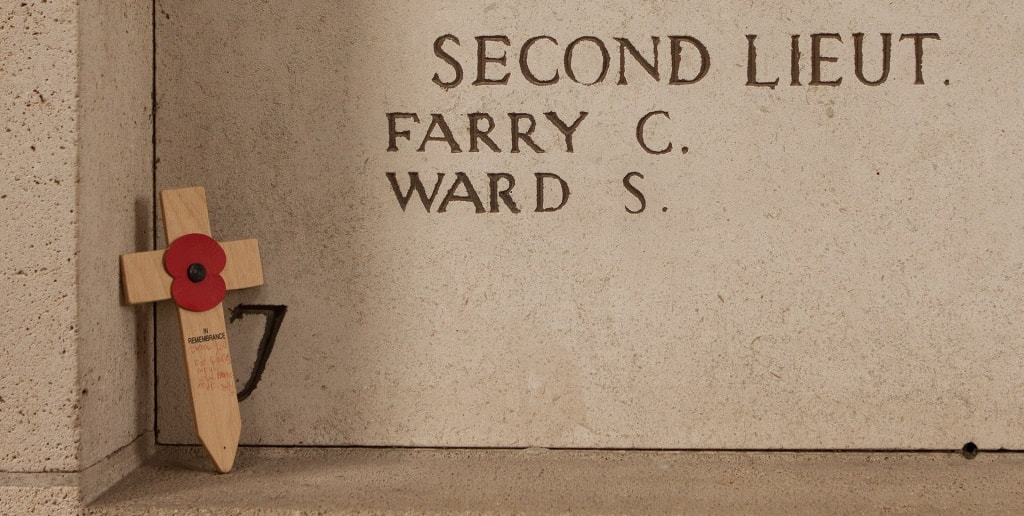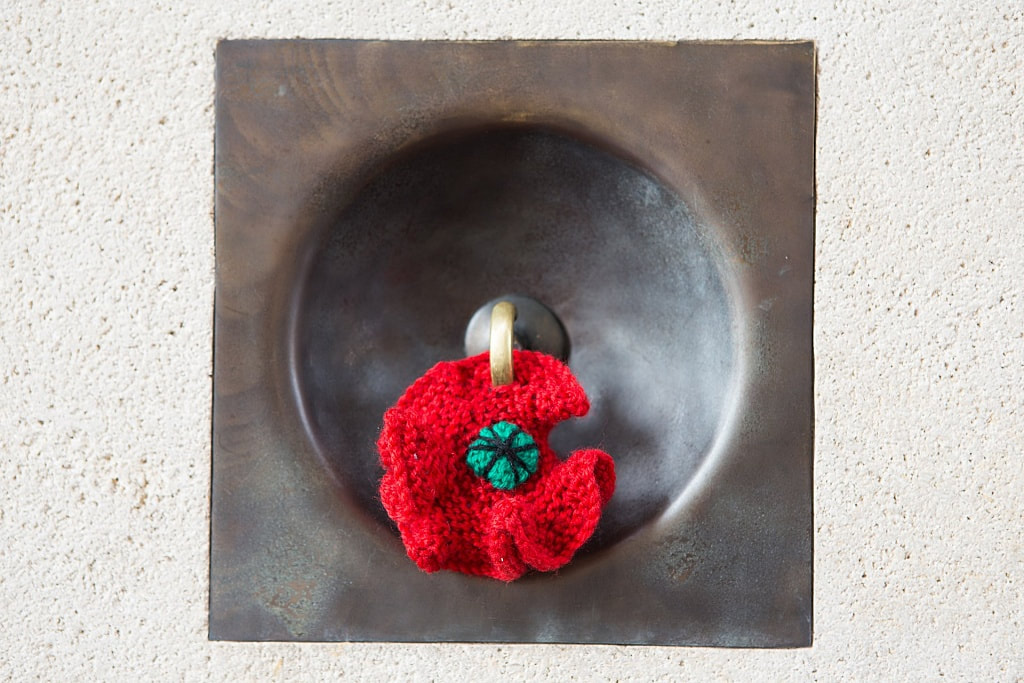MENIN GATE MEMORIAL
West-Vlaanderen
Belgium
GPS Coordinates: Latitude: 50.852028, Longitude: 2.890928
Roll of Honour
Listed by Surname

First World War period British Army location sign: this was the original British Army sign erected at the Menin Gate, Ypres, Belgium. It was replaced in 1917 after being damaged. 'At the time of the Great War, there was no actual gate on the site. It was indicated by the presence of two lions, one on each side of the roadway which cut through the walls. Through the cutting, many thousands of men wended their way to the Salient beyond.
Location Information
Ypres (now Ieper) is a town in the Province of West Flanders. The Memorial is situated at the eastern side of the town on the road to Menin (Menen) and Courtrai (Kortrijk).
Each night at 8 pm the traffic is stopped at the Menin Gate while members of the local Fire Brigade sound the Last Post in the roadway under the Memorial's arches.
Visiting Information
Panel Numbers quoted at the end of each entry relate to the panels dedicated to the Regiment with which the casualty served. In some instances, where a casualty is recorded as attached to another Regiment, his name may appear within their Regimental Panels. Please refer to the on-site Memorial Register Introduction. The Addenda Panel lists those service personnel whose details are awaiting addition to the Regimental Panels. All odd panel numbers are on the North side of the road and even numbers are located on the South side of the road.
Steps on either side of the memorial leading to the rear of the memorial, make wheelchair access to the rear impossible. There is however, a slope at the side of the memorial which gives wheelchair users some access but due to the incline, it may not be possible to ascend/descend unaided.
Please note that every Friday, all wreaths positioned under the Menin Gate are checked and removed as necessary, with the exception of those placed the previous evening.
Historical Information
The Menin Gate is one of four memorials to the missing in Belgian Flanders which cover the area known as the Ypres Salient. Broadly speaking, the Salient stretched from Langemarck in the north to the northern edge in Ploegsteert Wood in the south, but it varied in area and shape throughout the war.
The Salient was formed during the First Battle of Ypres in October and November 1914, when a small British Expeditionary Force succeeded in securing the town before the onset of winter, pushing the German forces back to the Passchendaele Ridge. The Second Battle of Ypres began in April 1915 when the Germans released poison gas into the Allied lines north of Ypres. This was the first time gas had been used by either side and the violence of the attack forced an Allied withdrawal and a shortening of the line of defence.
There was little more significant activity on this front until 1917, when in the Third Battle of Ypres an offensive was mounted by Commonwealth forces to divert German attention from a weakened French front further south. The initial attempt in June to dislodge the Germans from the Messines Ridge was a complete success, but the main assault north-eastward, which began at the end of July, quickly became a dogged struggle against determined opposition and the rapidly deteriorating weather. The campaign finally came to a close in November with the capture of Passchendaele.
The German offensive of March 1918 met with some initial success, but was eventually checked and repulsed in a combined effort by the Allies in September.
The battles of the Ypres Salient claimed many lives on both sides and it quickly became clear that the commemoration of members of the Commonwealth forces with no known grave would have to be divided between several different sites.
The site of the Menin Gate was chosen because of the hundreds of thousands of men who passed through it on their way to the battlefields. It commemorates casualties from the forces of Australia, Canada, India, South Africa and United Kingdom who died in the Salient. In the case of United Kingdom casualties, only those prior 16 August 1917 (with some exceptions). United Kingdom and New Zealand servicemen who died after that date are named on the memorial at Tyne Cot, a site which marks the furthest point reached by Commonwealth forces in Belgium until nearly the end of the war. New Zealand casualties that died prior to 16 August 1917 are commemorated on memorials at Buttes New British Cemetery and Messines Ridge British Cemetery.
The YPRES (MENIN GATE) MEMORIAL now bears the names of 54,370 officers and men whose graves are not known. The memorial, designed by Sir Reginald Blomfield with sculpture by Sir William Reid-Dick, was unveiled by Lord Plumer on 24 July 1927.
Commemorated on the Memorial: United Kingdom 40,292, Canada 6,927, Australia 6,179, South Africa 560, India 412. Total 54,370.
Ypres (now Ieper) is a town in the Province of West Flanders. The Memorial is situated at the eastern side of the town on the road to Menin (Menen) and Courtrai (Kortrijk).
Each night at 8 pm the traffic is stopped at the Menin Gate while members of the local Fire Brigade sound the Last Post in the roadway under the Memorial's arches.
Visiting Information
Panel Numbers quoted at the end of each entry relate to the panels dedicated to the Regiment with which the casualty served. In some instances, where a casualty is recorded as attached to another Regiment, his name may appear within their Regimental Panels. Please refer to the on-site Memorial Register Introduction. The Addenda Panel lists those service personnel whose details are awaiting addition to the Regimental Panels. All odd panel numbers are on the North side of the road and even numbers are located on the South side of the road.
Steps on either side of the memorial leading to the rear of the memorial, make wheelchair access to the rear impossible. There is however, a slope at the side of the memorial which gives wheelchair users some access but due to the incline, it may not be possible to ascend/descend unaided.
Please note that every Friday, all wreaths positioned under the Menin Gate are checked and removed as necessary, with the exception of those placed the previous evening.
Historical Information
The Menin Gate is one of four memorials to the missing in Belgian Flanders which cover the area known as the Ypres Salient. Broadly speaking, the Salient stretched from Langemarck in the north to the northern edge in Ploegsteert Wood in the south, but it varied in area and shape throughout the war.
The Salient was formed during the First Battle of Ypres in October and November 1914, when a small British Expeditionary Force succeeded in securing the town before the onset of winter, pushing the German forces back to the Passchendaele Ridge. The Second Battle of Ypres began in April 1915 when the Germans released poison gas into the Allied lines north of Ypres. This was the first time gas had been used by either side and the violence of the attack forced an Allied withdrawal and a shortening of the line of defence.
There was little more significant activity on this front until 1917, when in the Third Battle of Ypres an offensive was mounted by Commonwealth forces to divert German attention from a weakened French front further south. The initial attempt in June to dislodge the Germans from the Messines Ridge was a complete success, but the main assault north-eastward, which began at the end of July, quickly became a dogged struggle against determined opposition and the rapidly deteriorating weather. The campaign finally came to a close in November with the capture of Passchendaele.
The German offensive of March 1918 met with some initial success, but was eventually checked and repulsed in a combined effort by the Allies in September.
The battles of the Ypres Salient claimed many lives on both sides and it quickly became clear that the commemoration of members of the Commonwealth forces with no known grave would have to be divided between several different sites.
The site of the Menin Gate was chosen because of the hundreds of thousands of men who passed through it on their way to the battlefields. It commemorates casualties from the forces of Australia, Canada, India, South Africa and United Kingdom who died in the Salient. In the case of United Kingdom casualties, only those prior 16 August 1917 (with some exceptions). United Kingdom and New Zealand servicemen who died after that date are named on the memorial at Tyne Cot, a site which marks the furthest point reached by Commonwealth forces in Belgium until nearly the end of the war. New Zealand casualties that died prior to 16 August 1917 are commemorated on memorials at Buttes New British Cemetery and Messines Ridge British Cemetery.
The YPRES (MENIN GATE) MEMORIAL now bears the names of 54,370 officers and men whose graves are not known. The memorial, designed by Sir Reginald Blomfield with sculpture by Sir William Reid-Dick, was unveiled by Lord Plumer on 24 July 1927.
Commemorated on the Memorial: United Kingdom 40,292, Canada 6,927, Australia 6,179, South Africa 560, India 412. Total 54,370.
The Unveiling - 24th July 1927 - ©CWGC

The Menin Gate Lions were donated to the Commonwealth of Australia by the Burgomaster of Ypres in 1936. The lions each hold the Ypres Coat of Arms. The lions were given to the Australian government as a gesture of friendship. In exchange, in 1938, the Memorial gave a bronze casting of C. Web Gilbert’s sculpture Digger on behalf of the Australian government. The inscription on the casting of Digger reads: 'In assurance of a friendship that will not be forgotten even when the last digger has gone west and the last grave is crumbled'.
The lions are made of calcareous blue stone (sometimes also called 'little granite'), a blue-grey coloured stone from the provinces of Hainaut, Namur and Liege in Belgium. It is quarried exclusively in Belgium and is constituted from fossilised marine organisms. The stone used for the lions was probably quarried at Soignies, Belgium, with industrial extraction of the stone beginning in 1668. The exact date of the manufacture of the Menin Gate lions is unknown but is thought to be c.1638-1700. Records from 1937 date the Menin Gate Lions from the 1500s. The history of Menin Gate goes back to Louis XIV (1638-1715). He was responsible for the erection of ramparts around the city of Ypres. The walls around the city were pierced by two gates, one on the road to Lille being named the Lille Gate, the other the Menin Gate. In c.1830 the fortifications were modernised by the Dutch government and subsequently dismantled by the Belgian government in 1855-56. At this time, the Menin Gate lions were placed on brick plinths on either side of the Menin Road cutting where the Menin Gate once stood, an entrance to the medieval walled city of Ypres. It was through the Menin Gate that allied soldiers marched to the battlefields of the Ypres salient between 1914 and 1918. The 'Barrier Miner' (Broken Hill; 28/8/1936, p.3) newspaper noted; 'Through this historic gate during the war marched the great armies of the British Empire, France, the United States and Belgium, who fought in the battle of Ypres'. Similarly, the 'Adelaide News' (27/8/1936, p.9) notes; 'The Menin Gate was pulled down 80 years ago, but hundreds of thousands of allied troops, including many Australians, marched through the passageway in the ramparts during the great war'. After the First World War War, the Menin Gate was chosen as the site for a memorial, the Menin Gate Memorial to the Missing, dedicated to the British and Commonwealth soldiers who were killed in the Ypres Salient and whose graves are unknown. The memorial, designed by British architect Sir Archibald Blomfield, was unveiled on 24 July 1927 and consists of an imposing archway surmounted by a recumbent lion. It is inscribed with the names of 54,900 dead from Britain and Commonwealth countries.
Both Menin Gate lions were deeply chipped across their backs, and one had lost its right foreleg. The lions were chipped and damaged by shell fragments during the bombardment of Ypres during the First World War and when they arrived at the War Memorial, only one was in a suitable condition for display. The other had been badly damaged on one side of its head, and major damage elsewhere had reduced it to only a head and trunk ending just below the ribcage. When the lions arrived at the Memorial in September 1936, the building was not yet complete and lacked a suitable space to display them properly, although the lion with the missing leg was displayed by itself for several years. It was decided in 1985 to reconstruct the missing pieces of each lion in such a way that it would be obvious what was original and what was reconstructed. The reconstructed portions were designed so that they could be dismantled to return the sculptures to their original state, should that prove necessary. The work was done by Kasimiers L. Zywuszko, a Polish-born sculptor, with the assistance of period photographs obtained from Ypres. It was completed in 1987. The lions returned to display in 1991. After double checking the load-bearing capacity of the foyer floor, the lions were lifted by crane over the Memorial steps and placed inside the front entrance. All visitors now pass between the lions as they enter the building.
The lions are made of calcareous blue stone (sometimes also called 'little granite'), a blue-grey coloured stone from the provinces of Hainaut, Namur and Liege in Belgium. It is quarried exclusively in Belgium and is constituted from fossilised marine organisms. The stone used for the lions was probably quarried at Soignies, Belgium, with industrial extraction of the stone beginning in 1668. The exact date of the manufacture of the Menin Gate lions is unknown but is thought to be c.1638-1700. Records from 1937 date the Menin Gate Lions from the 1500s. The history of Menin Gate goes back to Louis XIV (1638-1715). He was responsible for the erection of ramparts around the city of Ypres. The walls around the city were pierced by two gates, one on the road to Lille being named the Lille Gate, the other the Menin Gate. In c.1830 the fortifications were modernised by the Dutch government and subsequently dismantled by the Belgian government in 1855-56. At this time, the Menin Gate lions were placed on brick plinths on either side of the Menin Road cutting where the Menin Gate once stood, an entrance to the medieval walled city of Ypres. It was through the Menin Gate that allied soldiers marched to the battlefields of the Ypres salient between 1914 and 1918. The 'Barrier Miner' (Broken Hill; 28/8/1936, p.3) newspaper noted; 'Through this historic gate during the war marched the great armies of the British Empire, France, the United States and Belgium, who fought in the battle of Ypres'. Similarly, the 'Adelaide News' (27/8/1936, p.9) notes; 'The Menin Gate was pulled down 80 years ago, but hundreds of thousands of allied troops, including many Australians, marched through the passageway in the ramparts during the great war'. After the First World War War, the Menin Gate was chosen as the site for a memorial, the Menin Gate Memorial to the Missing, dedicated to the British and Commonwealth soldiers who were killed in the Ypres Salient and whose graves are unknown. The memorial, designed by British architect Sir Archibald Blomfield, was unveiled on 24 July 1927 and consists of an imposing archway surmounted by a recumbent lion. It is inscribed with the names of 54,900 dead from Britain and Commonwealth countries.
Both Menin Gate lions were deeply chipped across their backs, and one had lost its right foreleg. The lions were chipped and damaged by shell fragments during the bombardment of Ypres during the First World War and when they arrived at the War Memorial, only one was in a suitable condition for display. The other had been badly damaged on one side of its head, and major damage elsewhere had reduced it to only a head and trunk ending just below the ribcage. When the lions arrived at the Memorial in September 1936, the building was not yet complete and lacked a suitable space to display them properly, although the lion with the missing leg was displayed by itself for several years. It was decided in 1985 to reconstruct the missing pieces of each lion in such a way that it would be obvious what was original and what was reconstructed. The reconstructed portions were designed so that they could be dismantled to return the sculptures to their original state, should that prove necessary. The work was done by Kasimiers L. Zywuszko, a Polish-born sculptor, with the assistance of period photographs obtained from Ypres. It was completed in 1987. The lions returned to display in 1991. After double checking the load-bearing capacity of the foyer floor, the lions were lifted by crane over the Memorial steps and placed inside the front entrance. All visitors now pass between the lions as they enter the building.
Images in this gallery © Geerhard Joos
Shot at Dawn
3832 Private Herbert Francis Burden, 1st Bn. Northumberland Fusiliers, executed for desertion 21st July 1915, aged 17. Addenda Panel 60. Enlisted giving an age of 18, when he was in fact 16.
Lewisham-born, he enlisted with the Northumberland Fusiliers in or about May 1914, aged 16 years & 2 months, but gave his age as 18. Burden deserted from the regiment & returned to London where in Nov 1914 he enlisted into the 3rd East Surreys, his attestation papers giving his age as 19 years & 240 days. 3 weeks later he deserted from his new regiment & returned to the Northumberland Fusiliers. Burden then went to France with this regiment as soon as he reached — according to this regiment’s records — the age of 19. He deserted when his unit was suffering enormous losses on Bellwarde Ridge, & was found at some stage later in the lines of the Royal West Kents.
At trial on 2 July 1915 — where he was unrepresented —he explained that he had gone to visit a friend serving in that regiment. After conviction, there was no dissent from the sentence of death, which was carried out almost 3 weeks later. (Corns, pp 294-298; Putkowski, p 48).
The "Shot At Dawn" Memorial at the National Arboretum in Staffordshire is modelled on Private Burden (Sculptor Andy de Comyn)
TH/040862 Driver Thomas Moore, 4th Coy. 24th Divisional Train, Army Service Corps. executed for murder 26th February 1916, aged 26. Panel 56.
In the evening of 11 Feb 1916, Moore was in his hut at Busseboom (in Belgium). After the men in the hut had been told by an officer to quieten down, he loaded his rifle & fired through the roof. When 2 senior NCOs arrived, Moore threatened them & an officer. He then left the hut, apparently in search of Sergeant Major Bagshawe, & soon after fired 2 shots, which hit his friend Staff Sgt Pick — who shortly before had been heard to tell Moore to: ‘Chuck it’. He died shortly afterwards. The battalion MO thought that the second shot had been fired from above, while the victim was on the ground.
When the CO arrived later that evening, Moore — by now secured — said: ‘Put a bullet through me’, & confirmed that he had been after Bagshawe, having nothing against Pick. The MO who saw Moore soon afterwards found him semi-conscious, seemingly recovering from drunkenness.
At trial, Moore — who had a prisoner’s friend — handed in a written statement. In it, he said that Pick had joined him & his friends earlier that evening in an estaminet; that they had walked together back to the camp; that Pick had given him a drink from a bottle; & that he remembered nothing except wrestling with someone in the doorway of the hut.
Following conviction, previous offences of drunkenness, & of recklessly firing a rifle etc were revealed. In mitigation, Moore said that he was ‘out of his mind at the time’, & ‘didn’t know what happened’. All the unit commanders recommended execution, the sentence being confirmed on 23 Feb 1916. (Corns, pp.365-367)
Sgt Pick is buried in Poperinghe New Military Cemetery in Belgium.
10459 Corporal George Povey, 1st Bn. Cheshire Regiment, executed for leaving his post 11th February 1915, aged 23. Panel 19 - 22. Son of Mrs. Dinah Povey, of 51, Primrose Street, Connah Quay.
On 28 Jan 1915, his battalion was holding the line near Wulverghem, when a sudden panic was caused by someone shouting that the Germans were in the trench. This had apparently arisen when a German, seemingly alone, had crept right up, & pulled a rifle out of a loophole in the trench. Several men, including Povey ran rearwards before being stopped at a support point.
At trial, Povey said that he had awoken on hearing the words: ‘Clear out, lads, they’re on us’; that he had followed several men running away; that when stopped he had all his arms & equipment with him; & that he had returned to the front line when ordered.
The privates were sentenced to 10 years’ Penal Servitude (later reduced), but on Corporal Povey a death sentence was imposed, & readily confirmed.(Corns, pp. 139-140, 153)
6922 Private William Scotton, 4th Bn. Middlesex Regiment, executed for desertion 3rd February 1915, aged 19. Panel 49 and 51. Son of Mrs. Catherine Scotton, of 52, Gladstone Road, Walton, Liverpool. His brother, Albert also fell and is commemorated on the Thiepval Memorial.
William enlisted in late July 1914, he was convicted of Absence in December, repeating the offence in January when his platoon was warned for the trenches. He reported himself the next day, leading to trial. The court-martial papers carried comments suggesting that he was a weakling, & that battalion discipline was bad. The whole battalion was paraded for his execution, which was carried out by a squad from his own unit. (Putkowski, p. 31)
The four Shot at Dawn Commemorations below © Geerhard Joos
3832 Private Herbert Francis Burden, 1st Bn. Northumberland Fusiliers, executed for desertion 21st July 1915, aged 17. Addenda Panel 60. Enlisted giving an age of 18, when he was in fact 16.
Lewisham-born, he enlisted with the Northumberland Fusiliers in or about May 1914, aged 16 years & 2 months, but gave his age as 18. Burden deserted from the regiment & returned to London where in Nov 1914 he enlisted into the 3rd East Surreys, his attestation papers giving his age as 19 years & 240 days. 3 weeks later he deserted from his new regiment & returned to the Northumberland Fusiliers. Burden then went to France with this regiment as soon as he reached — according to this regiment’s records — the age of 19. He deserted when his unit was suffering enormous losses on Bellwarde Ridge, & was found at some stage later in the lines of the Royal West Kents.
At trial on 2 July 1915 — where he was unrepresented —he explained that he had gone to visit a friend serving in that regiment. After conviction, there was no dissent from the sentence of death, which was carried out almost 3 weeks later. (Corns, pp 294-298; Putkowski, p 48).
The "Shot At Dawn" Memorial at the National Arboretum in Staffordshire is modelled on Private Burden (Sculptor Andy de Comyn)
TH/040862 Driver Thomas Moore, 4th Coy. 24th Divisional Train, Army Service Corps. executed for murder 26th February 1916, aged 26. Panel 56.
In the evening of 11 Feb 1916, Moore was in his hut at Busseboom (in Belgium). After the men in the hut had been told by an officer to quieten down, he loaded his rifle & fired through the roof. When 2 senior NCOs arrived, Moore threatened them & an officer. He then left the hut, apparently in search of Sergeant Major Bagshawe, & soon after fired 2 shots, which hit his friend Staff Sgt Pick — who shortly before had been heard to tell Moore to: ‘Chuck it’. He died shortly afterwards. The battalion MO thought that the second shot had been fired from above, while the victim was on the ground.
When the CO arrived later that evening, Moore — by now secured — said: ‘Put a bullet through me’, & confirmed that he had been after Bagshawe, having nothing against Pick. The MO who saw Moore soon afterwards found him semi-conscious, seemingly recovering from drunkenness.
At trial, Moore — who had a prisoner’s friend — handed in a written statement. In it, he said that Pick had joined him & his friends earlier that evening in an estaminet; that they had walked together back to the camp; that Pick had given him a drink from a bottle; & that he remembered nothing except wrestling with someone in the doorway of the hut.
Following conviction, previous offences of drunkenness, & of recklessly firing a rifle etc were revealed. In mitigation, Moore said that he was ‘out of his mind at the time’, & ‘didn’t know what happened’. All the unit commanders recommended execution, the sentence being confirmed on 23 Feb 1916. (Corns, pp.365-367)
Sgt Pick is buried in Poperinghe New Military Cemetery in Belgium.
10459 Corporal George Povey, 1st Bn. Cheshire Regiment, executed for leaving his post 11th February 1915, aged 23. Panel 19 - 22. Son of Mrs. Dinah Povey, of 51, Primrose Street, Connah Quay.
On 28 Jan 1915, his battalion was holding the line near Wulverghem, when a sudden panic was caused by someone shouting that the Germans were in the trench. This had apparently arisen when a German, seemingly alone, had crept right up, & pulled a rifle out of a loophole in the trench. Several men, including Povey ran rearwards before being stopped at a support point.
At trial, Povey said that he had awoken on hearing the words: ‘Clear out, lads, they’re on us’; that he had followed several men running away; that when stopped he had all his arms & equipment with him; & that he had returned to the front line when ordered.
The privates were sentenced to 10 years’ Penal Servitude (later reduced), but on Corporal Povey a death sentence was imposed, & readily confirmed.(Corns, pp. 139-140, 153)
6922 Private William Scotton, 4th Bn. Middlesex Regiment, executed for desertion 3rd February 1915, aged 19. Panel 49 and 51. Son of Mrs. Catherine Scotton, of 52, Gladstone Road, Walton, Liverpool. His brother, Albert also fell and is commemorated on the Thiepval Memorial.
William enlisted in late July 1914, he was convicted of Absence in December, repeating the offence in January when his platoon was warned for the trenches. He reported himself the next day, leading to trial. The court-martial papers carried comments suggesting that he was a weakling, & that battalion discipline was bad. The whole battalion was paraded for his execution, which was carried out by a squad from his own unit. (Putkowski, p. 31)
The four Shot at Dawn Commemorations below © Geerhard Joos
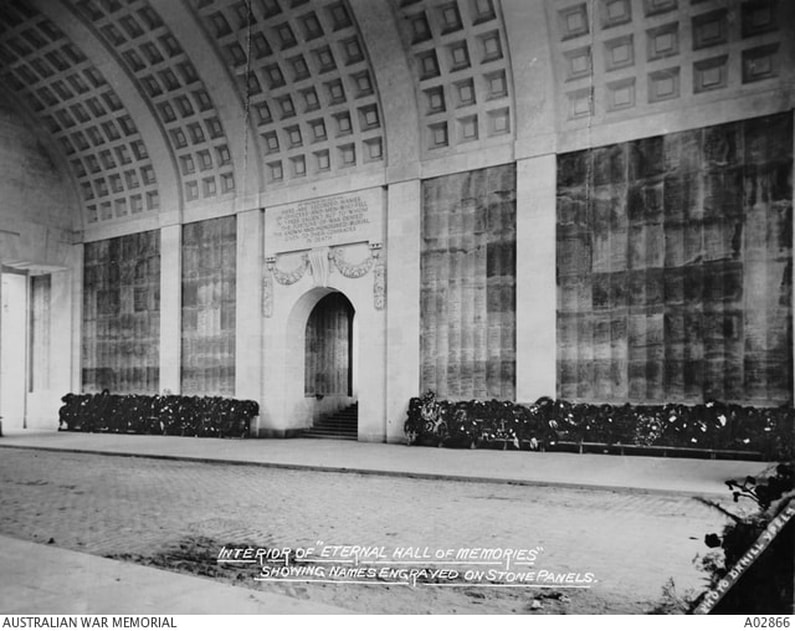
The Eternal Hall of Memories at Menin Gate Memorial, showing the names engraved on stone panels. The inscription above the door reads 'AD MAJOREM DEI GLORIAM HERE ARE RECORDED NAMES OF OFFICERS AND MEN WHO FELL IN YPRES SALIENT BUT TO WHOM THE FORTUNE OF WAR DENIED THE KNOWN AND HONOURED BURIAL GIVEN TO THEIR COMRADES IN DEATH'.

